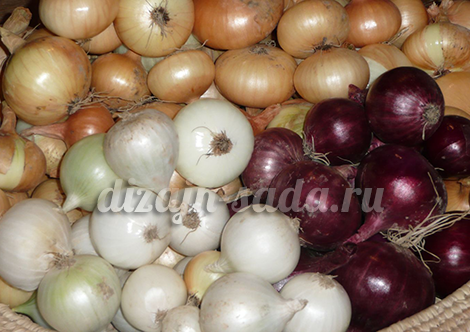Content
- 1 Basic requirements for pear varieties for Central Russia
- 2 Early (summer) varieties
- 3 Autumn varieties
- 4 Winter (late) varieties
- 5 The sweetest varieties
- 6 Summer pear varieties
- 7 Winter
- 8 Late
- 9 Autumn
- 10 Pear for the Volga region and central Russia
- 11 Garden varieties for the Moscow region, description
- 12 August dew
- 13 Veles
- 14 Duchess Summer (Williams)
- 15 Clapp's Favorite
- 16 Muscovite
- 17 Olivier de Serre
- 18 Simply Maria
- 19 Early varieties of summer pears for the middle lane: photo and description
- 20 What are the best winter-hardy pear varieties?
- 21 Photo and description of pear varieties of autumn ripening period
- 22 The most delicious varieties of autumn pears for the middle lane
- 23 The best varieties of winter pears: photo and description
The cultivation of pears in central Russia was not so long ago treated with caution. More whimsical, in comparison with an apple tree, it did not tolerate sudden changes in temperature, frost.
Thanks to the work of breeders, today the best varieties of pears have been bred for central Russia, which grow and bear fruit well. Read on for our selection of pear varieties with descriptions and photos.
Basic requirements for pear varieties for Central Russia
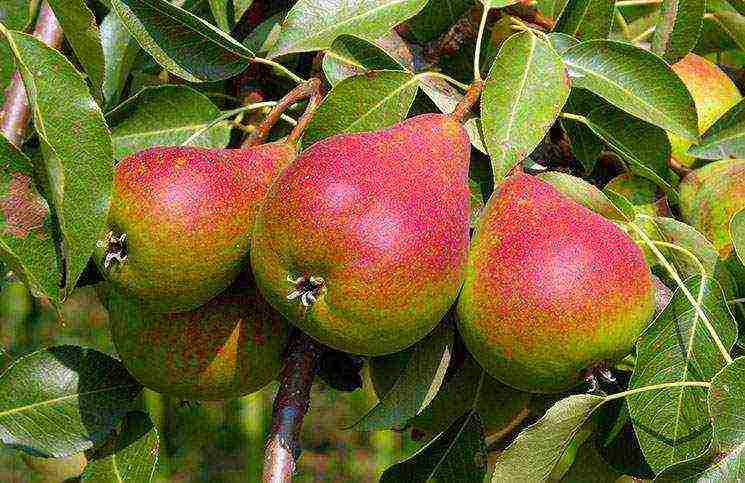
The pear is demanding on soil fertility, illumination, warmth and care. For her, choose a sunny place with fertile soil. If the soil on the site is poor, specially prepared soil is used to fill the large planting pit. The pear will more than thank the gardener for such care. Long-lived pear trees bear fruit for decades.
The best pear varieties for central Russia must meet the following requirements:
- Winter hardiness. For many years, due to its weak winter hardiness, the pear was considered a minor crop in central Russia compared to the apple tree. Modern pear varieties are even more hardy than some apple varieties.
- Taste properties. By choosing sweet and tender varieties, you can grow in the middle lane the same delicious fruits as in the south.
- Productivity. Depends heavily on planting and grooming.
- Early maturity. Most varieties begin to bear fruit in 3-5 years of life, some have to wait even 8 years.
- Self-pollination. Many pears are incapable of such a process. You should focus on at least a partially self-pollinated variety.
According to the harvest time, all varieties are divided into summer, autumn and winter.
Early (summer) varieties
To get a good harvest in the middle of summer or closer to the beginning of autumn, early varieties of pears are in constant demand. Such fruits have a very rich taste with a sour aftertaste, since they do not have time to fully absorb in a short period of solar activity.
Bashkir summer

A versatile, winter-hardy, fruitful (45-50 kg per tree), but not fertile variety.A medium-sized tree with a compact, rounded-pyramidal crown of medium density. Greenish-yellow fruits with a slight blush weigh about 100 g. White grainy pulp of medium density with good taste and aroma.
The messenger

Fast-growing table variety, fruitful, winter-hardy, scab resistant. Medium-sized tree with a sparse back-pyramidal crown. Ribbed-lumpy small (50-60 g) yellow fruits with a slight tan on a long stalk have a sweet taste and light creamy, slightly juicy aromatic pulp of medium density, which liquefies when ripe.
Dessert Rossoshanskaya
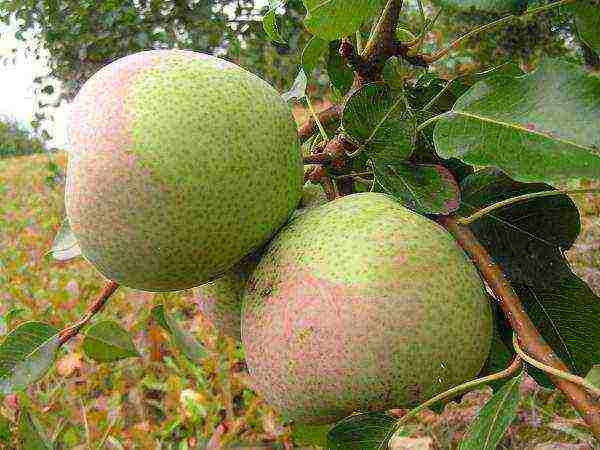
Fast-growing, versatile, fruitful (about 70 kg of fruits from one tree), winter-hardy variety with a rare, wide-pyramidal crown. Scab resistance is relative. Self-sterile. Large greenish-yellow fruits with a slight blush weigh about 200 g. The saucer and funnel are wide, the stalk is thick and curved. Delicate, juicy, white pulp of medium density has an excellent taste and aroma.
Children
One of the varieties with non-simultaneous, but the earliest ripening period. Winter-hardy, with high frost resistance of the ovaries. A vigorous tree has a compact crown, appreciated by gardeners for its durability. The fruits are bright yellow, with an orange blush, weigh about 80 g. The saucer is small, the funnel is absent, the stalk is short. Very tasty, semi-oily, tender and juicy creamy pulp. The yield from one tree reaches 20-30 kg.
Thumbelina

Low-growing (1.5 m), winter-hardy table variety, distinguished by non-simultaneous ripening of fruits and average yield. A medium-sized tree has a dense, rounded crown. Small, brownish-yellow, rusty fruits weighing 60-70 g without funnel, with tender, creamy, very juicy and sweet pulp. The yield reaches 45-50 kg per tree.
Isolde
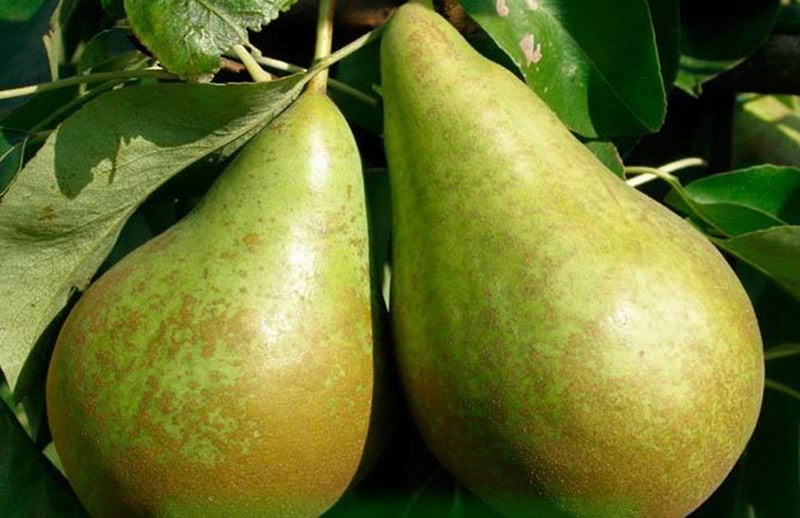
A productive early variety of German selection, resistant to frost and pear scab. A tree with a wide crown grows moderately quickly, ovaries form on the shoots. Bears fruit in the 3rd year. It is characterized by a regular abundance of juicy, medium and large (from 160 to 230 g) fruits with an attractive appearance and a bright red blush.
Cathedral

Scab-resistant, versatile, early-growing, winter-hardy variety. A medium-sized tree has a dense, rounded crown. Average yield - 35 kg per tree. Bright yellow fruit with a red blush without a funnel, with a shallow saucer and a thick beveled stalk, weigh about 120 g. The semi-oily, juicy, dense pulp has a wonderful taste and aroma.
Space
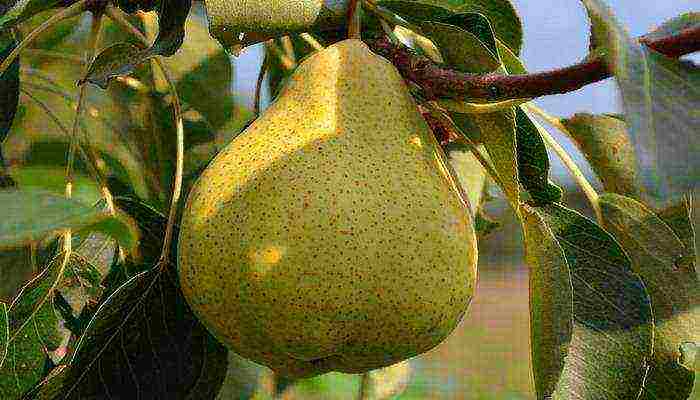
Low-fruiting table variety with a high yield (up to 150 kg per tree in some years), medium winter hardiness, relatively resistant to scab. Fruits, greenish-yellow with a slight blush, without a funnel, with a wide saucer. Fine-grained, sweet, juicy white flesh.
Marble
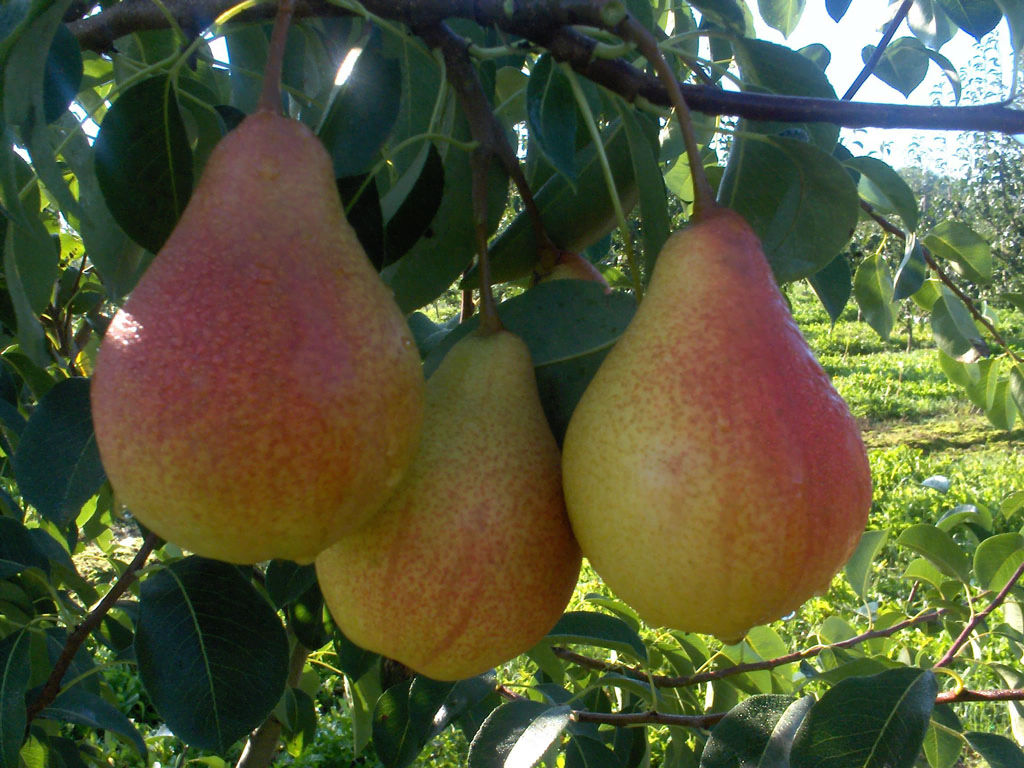
Yielding (about 90 kg per tree) and winter-hardy dessert variety. Relatively resistant to scab, early-growing. A medium-sized tree has a broad-pyramidal crown of medium density. Green-yellow fruits with a blurred blush or streaks and rusty subcutaneous dots weigh about 150 g. The saucer is small, the funnel is narrow, the stalk is inflated. Melting, juicy, coarse-grained, tender, juicy, creamy pulp has an excellent taste.
Oryol summer
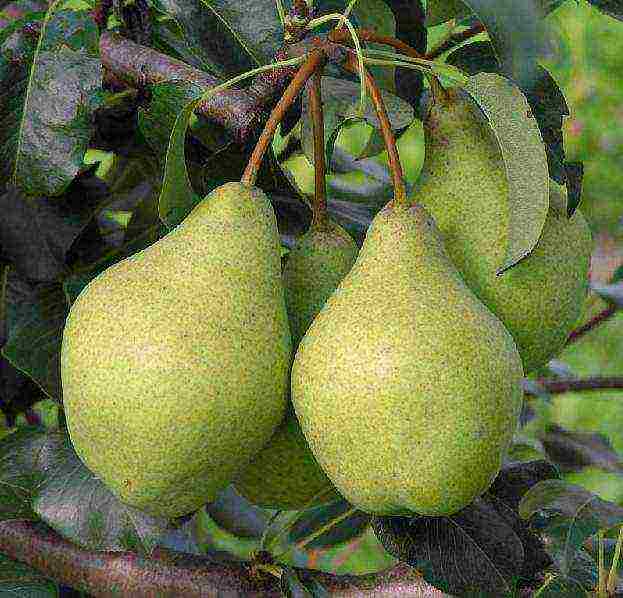
Yielding (35-40 kg per tree per season), early-growing, versatile variety with annual fruiting. Average winter hardiness, relatively resistant to scab. The tree is tall, with a broad-pyramidal crown of medium density. Large (250 g) greenish-yellow fruits with a shallow saucer, without a funnel, have a thick long stalk. Delicious, juicy, dense, semi-oily white pulp with a weak aroma.
Early July
A favorite pear variety for gardeners, which gives a stable yield (on average 60-65 kg per tree) every year. Fruits of the same size (weight 100-120 g) have a regular pear-shaped shape and a pronounced taste with a predominance of sweetness.Elastic flesh practically does not darken in the open air. The variety is suitable for juicing and fresh consumption. Not recommended for preservation because of the rapid loss of flavor saturation.
Rogneda

High-yielding (about 90 kg per tree), fast-growing, versatile variety with annual fruiting. It is resistant to scab. Medium-sized tree with a dense, compact, wide-pyramidal crown. Yellow, with a bright red blush, fruits with a deep funnel and a wide shallow saucer have a short peduncle. Fine-grained, juicy, dense pulp with sweet and sour taste and rich aroma. The fruit is characterized by an almost complete absence of acid.
Early ripening
Annually fruiting, disease and frost resistant variety. The tree is tall, fast-growing, with a pyramidal crown, begins to bear fruit in the 5th year. Fruits are uniform in size, small, with thin skin. Due to its soft and juicy pulp, without astringency, it is mainly used fresh and for making juices. Prone to defeat by moniliasis.
Autumn varieties
Autumn pears ripen in mid-September. They must be removed from the trees slightly unripe, avoiding falling off. After a few days of storage in a cool, dark place, they will be ready to eat.
Academic 4-112
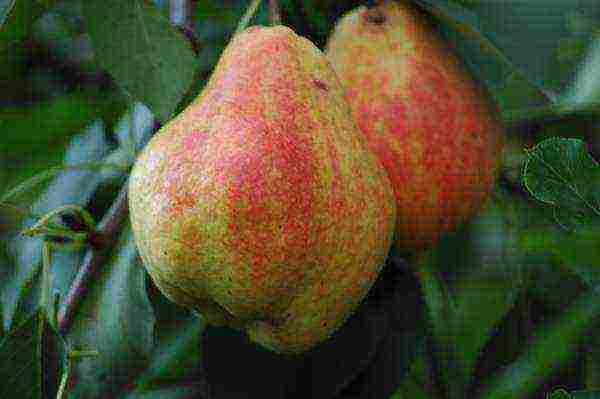
A universal variety with an average (50 kg per tree) yield and winter hardiness, it is resistant to scab. The dense compact crown has a wide pyramidal shape. The fruits are lumpy, pear-shaped, weighing from 130 to 150 g. The skin has a yellow main and dark-burgundy integumentary color. The saucer is ribbed, wide, the funnel is narrow and shallow. The thick peduncle is of medium length. Semi-oily, white, dense, juicy pulp tastes sweet and sour, with a weak aroma.
Bashkir autumn
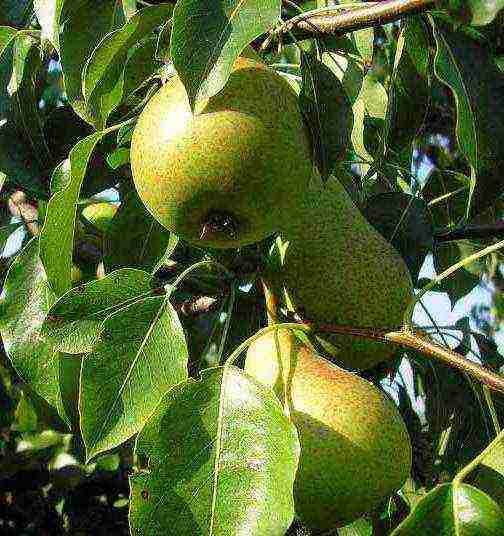
Early autumn high-yielding (70-80 kg per tree) table variety, relatively resistant to scab, winter-hardy. The fruits are elongated pear-shaped with a thick curved peduncle, a wide saucer and a funnel weigh about 75 g. The yellowish-green skin is covered with a blurred red blush on most of the fruit. Juicy fine-grained pulp of medium density has a creamy hue, medium aroma and sweet and sour taste.
Bergamot Moscow

A versatile variety with a higher than average winter hardiness and an average yield (20 kg per tree), it is resistant to scab. The crown of the tree is sparse, broadly oval. Rounded smooth fruits weighing 150-160 g with a yellowish-green skin have a weak pinkish integumentary color and well-visible large subcutaneous dots. The peduncle is thick, short, straight. The saucer is ribbed, wide. The funnel is of medium width and deep. Juicy, dense, aromatic pulp has a good, sour-sweet taste.
Bere Moskovskaya

Dessert variety with an average yield and high winter hardiness, it is resistant to scab. Weakly ribbed, elongated-conical fruits weighing up to 110 g are covered with a yellow skin with a slightly reddish integumentary color, on which small brown subcutaneous dots are clearly visible. Very juicy, dense, semi-oily pulp has a delicate aroma and dessert taste. In terms of juiciness and softness, the fruits are unmatched, but in hot, dry weather, the quality of the fruits deteriorates.
Veles

Disease resistant winter-hardy variety with high yields (from 50 to 100 kg per well-groomed adult tree), frost-resistant ovaries. Fruits weighing 120-150 g with a wide funnel and a small, smooth, wide saucer are covered with a yellowish-green skin with a slight orange tan and subcutaneous dots. Delicious creamy pulp is very tender, juicy, semi-oily.
Faithful
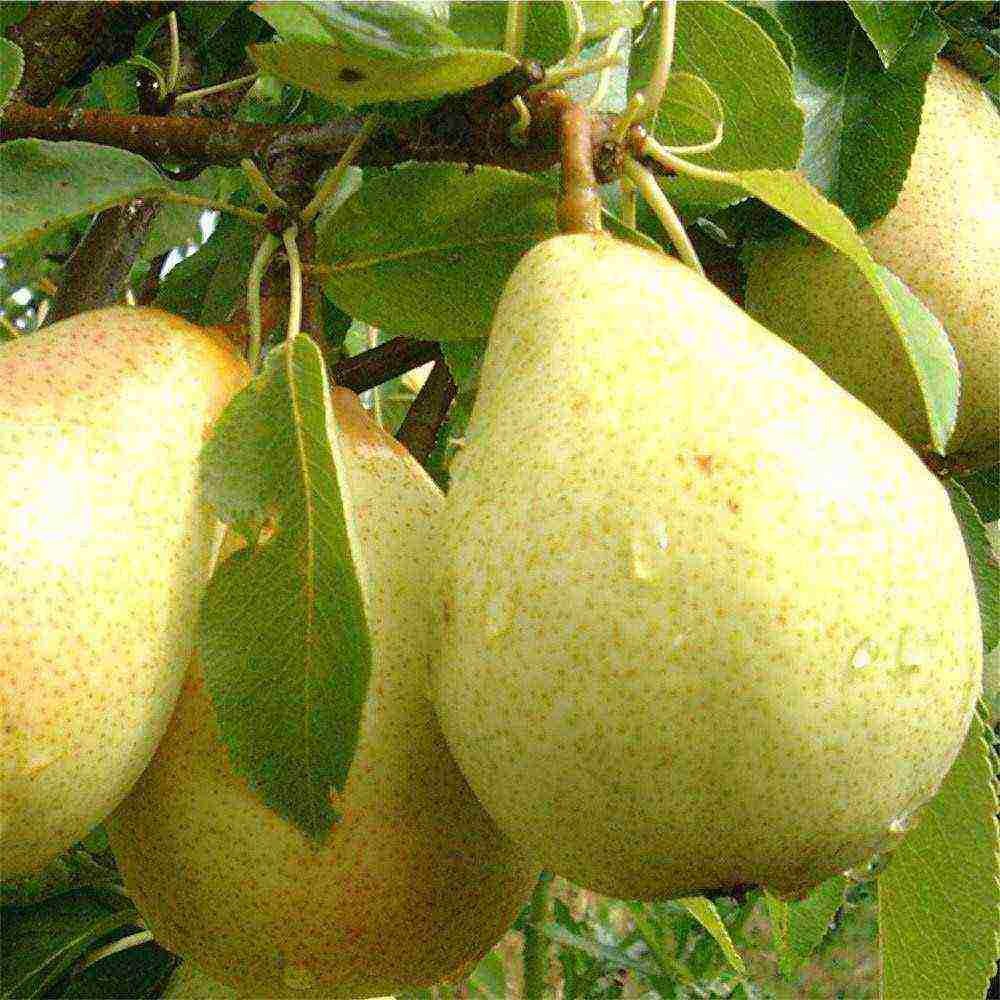
A high-yielding (about 100 kg per adult tree) late autumn variety with high winter hardiness (the ovaries can withstand frosts down to -2 ° C). Symmetrical, without a funnel, fruits with a slightly tanned yellowish skin and a short peduncle weigh from 90 to 130 g. The pulp is juicy, creamy, semi-oily, tasty.
Yeseninskaya
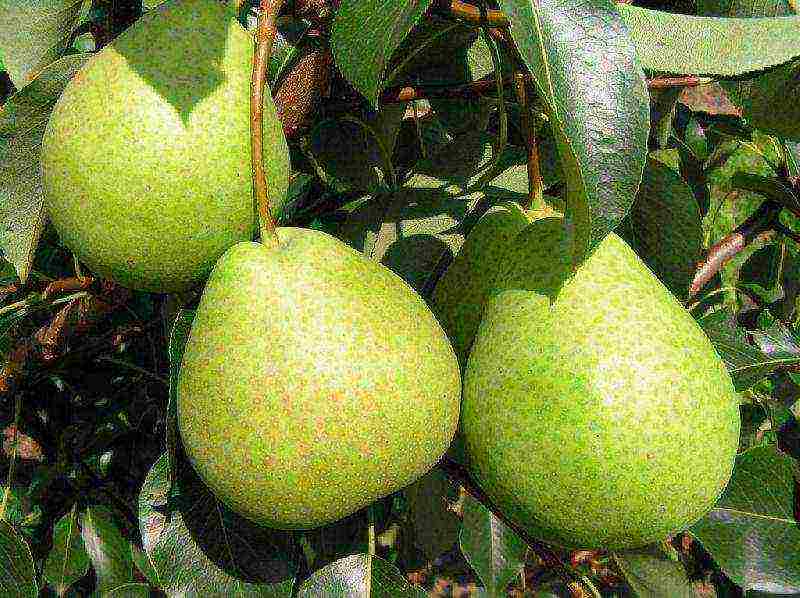
An early autumn high-yielding versatile variety (50 kg per tree), scab resistant. Smooth fruit weight about 140 grams with a very small funnel, and a wide shallow saucer covered with yellowish skin with an orange blush and highly visible subcutaneous red points. Polumaslyanistaya creamy pulp medium density taste sweet and sour, with a slight muscat flavor. It has high taste qualities of the fruit.
Beauty Chernenko
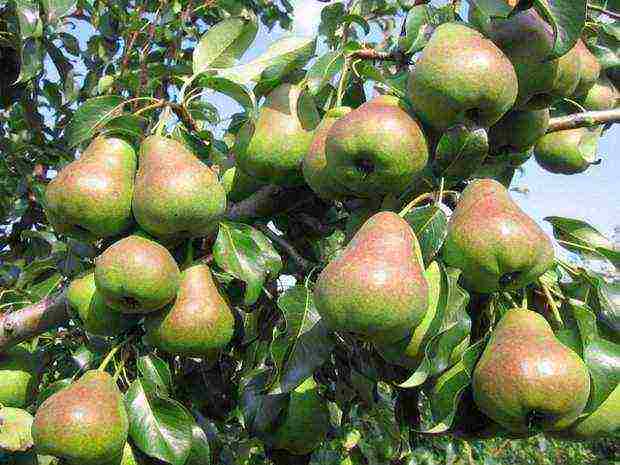
Table variety with high yields (80-85 kg per tree) and average hardiness. It is resistant to scab. A tree with a rare narrow-pyramidal crown. Large fruit on long thick stalk weighing up to 200 grams of golden-yellow color covered with red blush. The saucer is wide, shallow, the funnel is shallow. Juicy tasty flesh melts in your mouth.
Muscovite
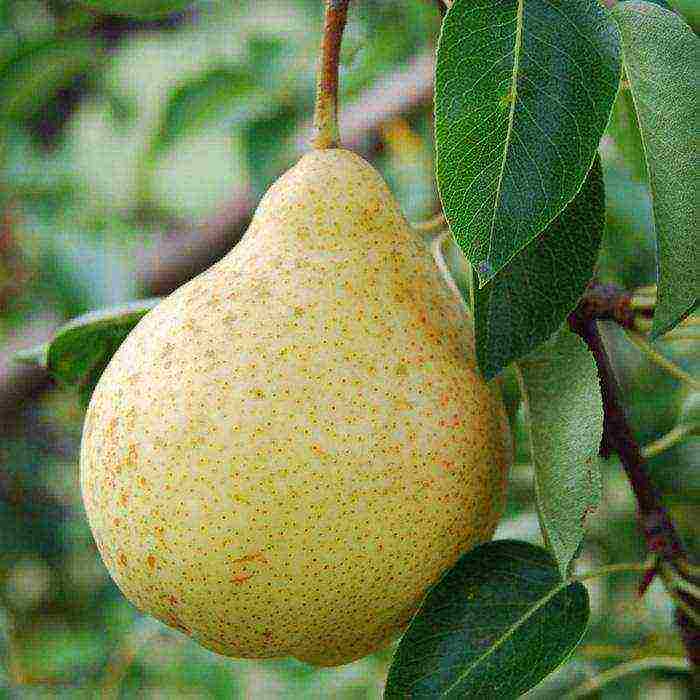
Early appearance, universal grade of high (35-40 kg per tree) yielding, resistant to rot and fruit scab. It has an average winter hardiness. From spring frosts does not suffer due to late flowering. The tree has a dense conical crown. Sized fruits with a greenish-yellow color with integumentary points and a slight blush, without a funnel, with a wide saucer. Thick, white, polumaslyanistaya, very juicy pulp with a strong aroma and delicious taste. Different fruit ripening friendly.
Muratovskaya
Urozhainy (60-70 kg per tree) table winterhardy varieties resistant to scab. Green-yellow, covered with crimson fruit with thick short peduncle are juicy, dense, polumaslyanistuyu flesh with a sweet and sour taste and weak aroma. Saucer narrow, no funnel.
Elegant Efimova
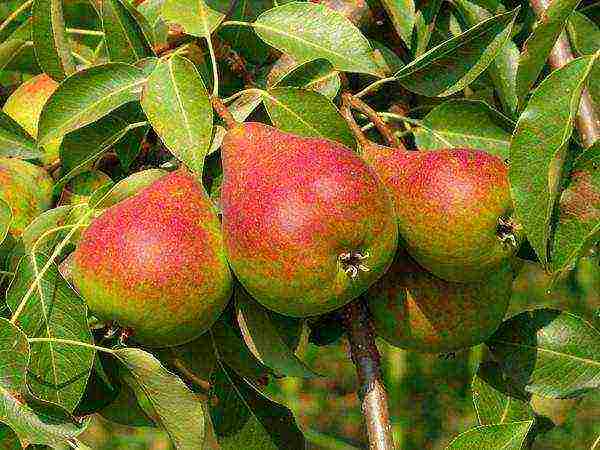
Table grade with an average winter hardiness and resistance to scab. Yields - 40 kg adult tree. The tree has a pyramidal crown of medium density. Yellow-green, very beautiful, bright red blush coated fruit weighing about 120 grams without funnel with a long shallow saucer with the influx stalk. Slightly tart, sweet, juicy, creamy flesh is very pleasant to the taste.
Otradnenskaya
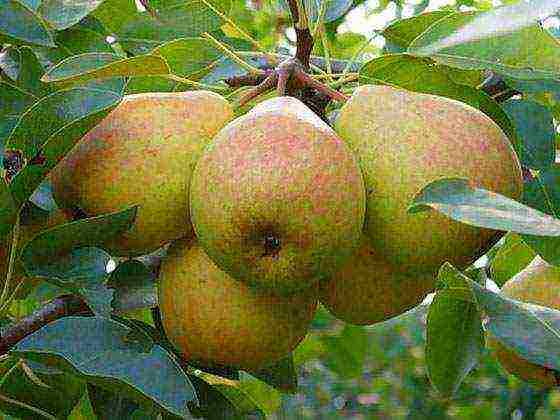
A fast-growing universal variety, medium-yielding (30-40 kg of fruits per tree), winter-hardy. Srednerosloe tree with a rounded, pyramidal, dense crown. Yellowish-green fruit with bright crimson weighing about 100 g with narrow funnel and a saucer and a long slender pedicle. The pulp is juicy, dense, sweet and sour taste.
Memory of Zhegalov
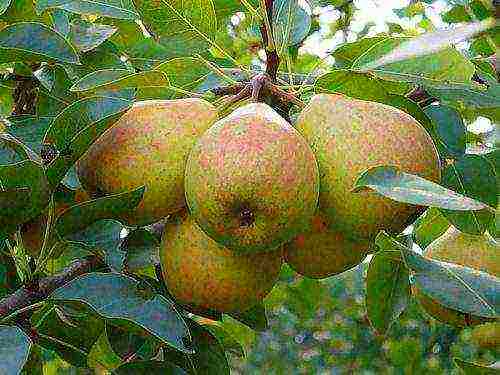
Universal winterhardy early appearance grade with an average yield (40 kg per tree), resistant to scab. Crohn's medium-thick schirokopiramidalnaya. Greenish-yellow fruit with a rusty hypodermic points weigh about 120 grams Saucer ribbed, wide, narrow funnel. Polumaslyanistaya, firm, juicy flesh is aromatic, with sweet-sour taste.
Potapovskaya
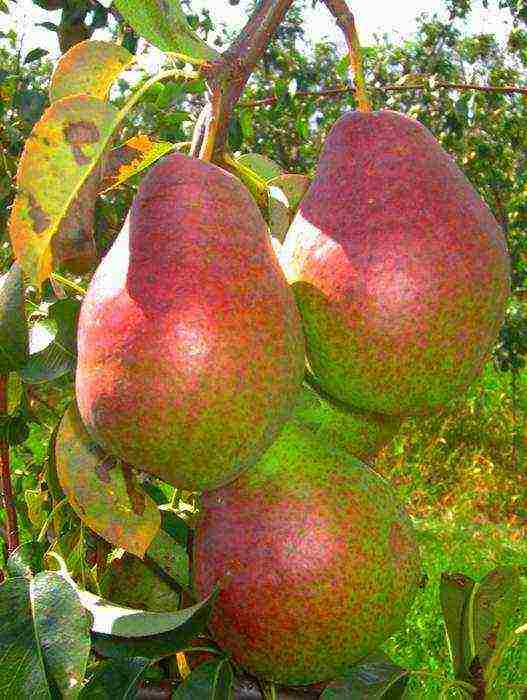
Winterhardy universal grade with thick pyramidal crown resistant to scab. Fruit weight about 140 g, the peel yellow with red blush. The saucer is small, there is no funnel, the stalk is medium in length and thickness. The flesh is slightly tart, juicy, dense, sweet-sour. Yields - 55 kg for the season with a mature tree.
Fabulous
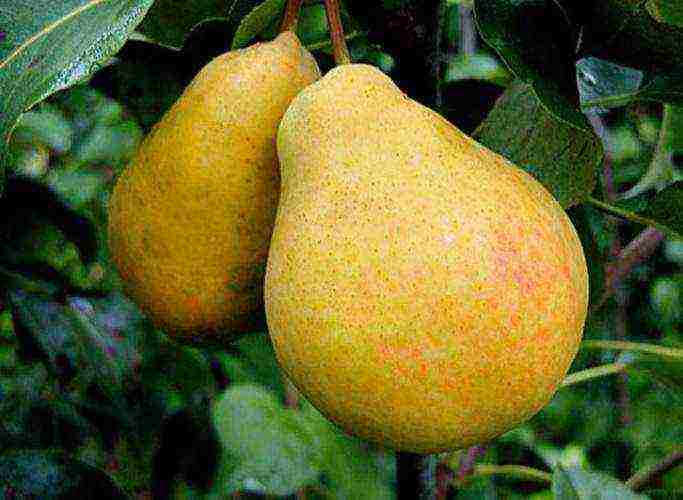
Neskoroplodny, drought, universal winterhardy resistant varieties and scab mite. Yields - about 10 kg of fruit per tree. Srednerosloe tree with a compact, narrow-pyramidal, crown slaboraskidistoy strongly overgrown shoots. Yellow-green fruit with slight blush covered multiple subcutaneous points. Sredneplotnaya, fine-grained, tender, juicy flesh is white with a very pleasant sweet-sour taste with spicy notes. Fruits have high safety, well tolerated transportation.
Chizhovskaya
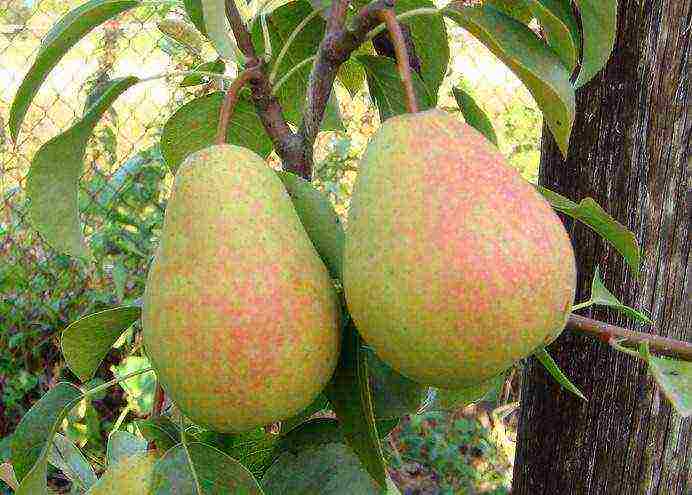
Universal early appearance (the 3rd year after planting seedling begins to bear) cultivar with an annual yield of 50 kg per tree, high hardiness, resistant to scab. The oval crown is of medium density. Fruit with yellow-green color, a weak glow and subcutaneous points weigh about 120 grams saucer shallow, narrow funnel, a short stalk.The pulp is semi-oily, juicy, dense, with a pleasant sweet and sour taste.
Winter (late) varieties
Fruits of late varieties cannot be brought into a warm room immediately after harvesting: they will harden or quickly begin to deteriorate.
Belarusian late

Lying, versatile, fast-growing, high-yielding variety (55-60 kg per tree), with increased winter hardiness. It is resistant to bacterial diseases, but it is affected by scab. A medium-sized tree has a dense crown. Fruits weighing 110-120 g are covered with a thick yellowish skin with rusty subcutaneous punctures, sometimes with a slight blush. Juicy, medium density, yellowish flesh with medium aroma and good taste. It can be stored in the basement until spring (longer than all varieties) (temperature from -1 ° C to 3 ° C, humidity about 80%).
Age-old

It is frost-resistant, not susceptible to fungal diseases. The tree gives its first harvest 5-6 years after planting. Fruit is harvested at the turn of September and October. Juicy and tasty fruits weighing 130-180 g with a light sourness palpable on the taste are stored for a month. The yield of one tree per season can reach 150 kg.
Festive
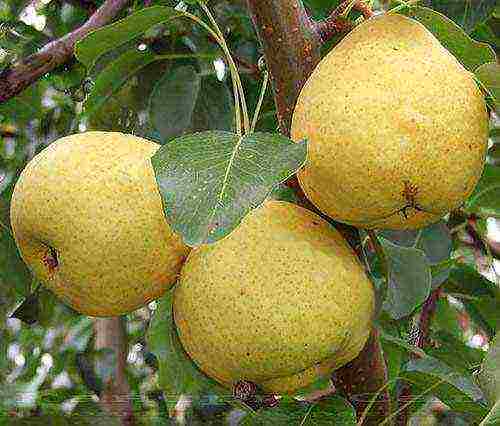
Pest-resistant winter variety with high yields (30-35 kg per tree) and pyramidal crown. Small (up to 100 g) fruits with firm juicy pulp, sweet and sour taste and aroma of tropical fruits have an average keeping quality.
Miracle woman

A winter-hardy variety, with high-quality insulation, withstands frosts down to -50 ° C, with a consistently high annual yield. Large (200-220 g) fruits with a pronounced aroma, sweet taste and sour aftertaste tend to fall off as they ripen.
January

Dessert, fruitful, stable, self-fertile variety, scab resistant. Drought resistance and winter hardiness are average. Medium-sized tree with a rounded crown of medium density. Golden yellow fruits without a funnel, with a medium-sized saucer, weighing 120-200 g with small subcutaneous punctures. Oily, white, medium-dense pulp with excellent taste and low aroma.
The sweetest varieties
Most ripe pears have a sweet taste, but there are varieties that will be just as sweet, even unripe.
Prominent
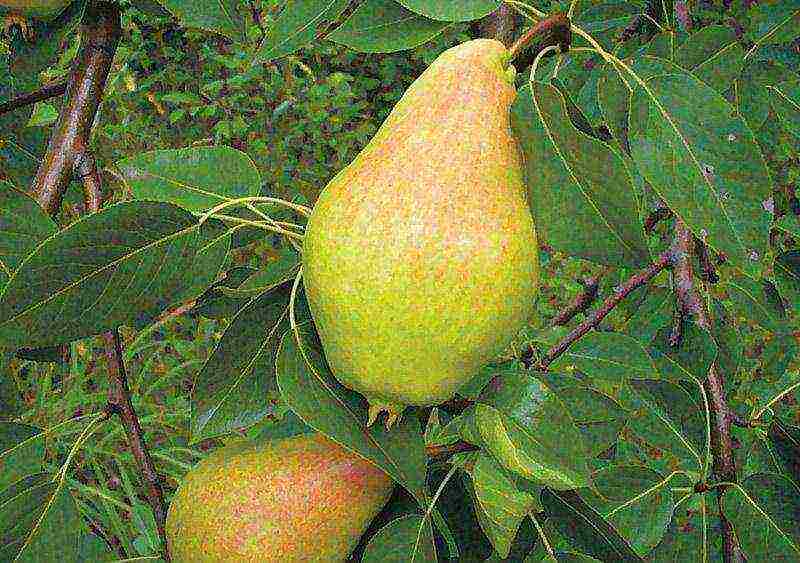
The variety is fruitful, fast-growing, versatile, winter-hardy, scab resistant. The ovaries are characterized by high frost resistance. The tree is vigorous, the crown is narrow-pyramidal. Fruits, greenish-yellow with a slight tan, weighing about 150 g, have a wide saucer, a narrow and shallow funnel, and a thick short stalk. Semi-oily, juicy, delicate white pulp with a good sweet taste.
The fruit is not stored even for several days, it is recommended to preserve it or immediately use it fresh.
Buttery sweet
A versatile variety in use, suitable for long-term storage, unpretentious care, disease resistant. Pears with a high concentration of sugar are not only consumed fresh, but they are also made into liqueurs, wine, and canned goods.
Autumn sweet
In terms of juiciness and richness of taste, it is not inferior to southern varieties, resistant to pests and insects, tolerates long-term frosts well. Fragrant fruits of bright yellow color with elastic, juicy pulp are stored for no more than a month.
As you know, pear varieties are subdivided into winter, autumn and summer varieties. Each category differs not only in terms of ripening, taste, but also in terms of storage of fruits... So, which varieties can be attributed to winter, and which ripen in summer, see the description below.
Summer pear varieties
August dew
 Pear August dew
Pear August dew
The undisputed favorite among summer pear varieties is August Dew, the result of a crossing of Tenderness and Triumph Pakgam varieties. The tree is rather low, less than 10 m in height, the bark is gray, smooth, the buds quickly "wake up" after winter. Branches are spreading, slightly drooping, curved. The leaves are oblong, medium in size, dark green in color. Fruits are of medium size, ripen in mid-summer.The taste is quite sweet, juicy, with white pulp and delicate skin.
Unfortunately, it is not suitable for long storage, the pear quickly turns brown and disappears. It is itself resistant to diseases and pests, easily tolerates winters, bears fruit every year, increasing the number of fruits. The disadvantage of this variety is that it constantly needs to trim the crown, because of this, the fruits become smaller.
Bere Giffard
 Pear variety Bere Giffard
Pear variety Bere Giffard
The same applies to summer varieties of pears. They differ from other varieties with their "ruddy" fruits, red-orange tones on one side of the pear, and light green shades on the other side. Formed on a branch in bundles, from 2 to 6 pieces, and keep that way until fully ripe. Due to the high yield, additional supports are often required, otherwise the branches may break under the weight of the fruit.
The fruits are tender, have a sweet taste, juicy, with white flesh. The tree reaches more than 10 m in height, a sparse crown, branches are slightly drooping and thin. The crown is brown, peels off. The leaf plate is dark green, oblong, with smooth edges. The variety does not tolerate severe winters, therefore, young seedlings require shelter. Fruits are poorly preserved when plucked, no more than a week.
Victoria
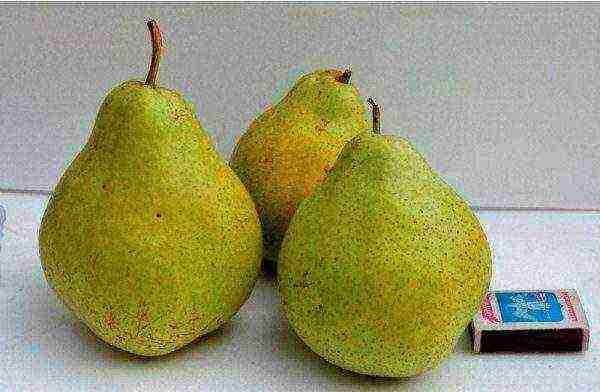 Winter-hardy pear variety Victoria
Winter-hardy pear variety Victoria
This variety is distinguished by its winter hardiness, is not afraid of drought and is rarely exposed to diseases and pests. It appeared as a result of crossing the varieties Bere Bosk and Tolstobezhka. Medium tree, 8-10 m, with a dense crown, has a pyramidal trunk shape, branches are long and thin. The variety is characterized by late vegetation, flowering. Productivity is high, more than 150 kg of harvest is harvested from an adult tree per year.
The pear begins to ripen in the second half of August, reaching its peak of maturity only by the middle of September. The fruits have a regular pear-shaped shape, with a smooth and thin skin.... The pear tastes sweet, with juicy pulp, and has a pleasant aroma. It is good to make jam and jams from this variety. But the pear is stored for a short time, in a torn form it does not deteriorate for about 3 days, it can hang on the tree for no more than a week, then it falls off.
Victoria is only half pollinated. To increase yields, it is recommended to plant it next to varieties such as Bere Dumont,
Williams
Red.
Duchess
 Summer pear variety Duchess
Summer pear variety Duchess
The name of the variety, translated as Duchess, was bred by an English breeder in Wheeler. The tree is not tall, 6-7 m, with a dense crown, branches are spreading, thin... The crown is a light brown tree, smooth.
Fruits begin to ripen in mid-August, the fruits are bright yellow. On average, one pear can weigh more than 150 g, are located on the branches singly or in groups of 4-6 pears. Stored up to 40 days on a tree and no more than 2 weeks when torn off... The fruit tastes juicy, sweet, with a thin skin and delicate aroma. The taste contains light notes of nutmeg and spices. The variety is frost-hardy, not afraid of cold weather. It is also not affected by scab, but copperhead and aphids are found on the tree very often.
How can you tell if summer pears can be picked from the tree? Firstly, if fallen fruits have already begun to appear on the ground, then the harvest is ready. Secondly, it can be determined by the color of the fruit, the ripe fruits become yellowish. Thirdly, if the pear has become soft to the touch, then it can be safely removed from the tree.
Severyanka
 Pear variety Severyanka
Pear variety Severyanka
It was bred by breeders for the northern regions, hence its name. The variety is medium-sized, tree height from 3 to 6 m, with a dense crown and a pyramidal shape of the trunk... Young seedlings easily tolerate planting and quickly begin their growth, but the tree begins to bear fruit in 4-5 years. The leaves of the tree are light green, pointed in shape, with smooth edges. It blooms in early spring, has more than 6 petals in the inflorescence /
A variety with a high yield, the fruits are strewn with branches, every year the harvest becomes larger, in the same way, the tree bears fruit every year. The pear is large, up to 200 grams each fruit, they are formed into small clusters of 4-6 pears... At the beginning of ripening, they have green tones, and then they acquire yellowish-orange shades. The skin of the fruit is loose, sometimes rather rough. The taste is not inferior to other varieties, sweet, with juicy pulp, has a sour-tart taste and light aroma. But there are not many seeds in the pear, they are located in special chambers in the heart of the fruit. It tolerates winters, diseases and pests well enough, does not need special care.
Cathedral
 Rapid pear variety Cathedral
Rapid pear variety Cathedral
The same applies to summer, early-growing varieties. It was bred by crossing Lesnaya Krasavitsa and Duchess Bedro varieties. It grows mainly in the Central regions, but due to its resistance to frost, it grows easily in the regions of the North. The tree is medium-sized, from 4 m in height and above, with a wide and dense crown, the branches look up... The trunk is smooth, brownish-gray. Young shoots are slightly drooping, reddish-brown in color, fruiting occurs on them. Leaves are green, smooth, medium in size.
Fruiting begins from the 6th year, the weight of a pear can exceed 130 grams. Ripening occurs in mid-August, the fruits remain on the tree for no more than 2 weeks, even less when plucked. Lemon-colored fruit with many splashes, change their shades closer from autumn to red-orange, which indicates full ripening of the fruit. The skin is thin, the flesh is creamy or white, sweet with a pleasant aroma, medium density. In the middle of the fruit are brown seeds, elongated.
Summer varieties of pears ripen by mid-summer, it is important to remember about their proper care. Summer pears love moisture in spring and especially during fruit formation. For the harvest to be faster, the tree needs annual pruning and feeding.
Winter
Saratovka
Obtained as a result of crossing the varieties Bere and Bergamot... They worked on a new variety at the Saratov State Agrarian University named after V.I. Vavilov. Refers to winter, plucked fruits under the right conditions can be stored until February!
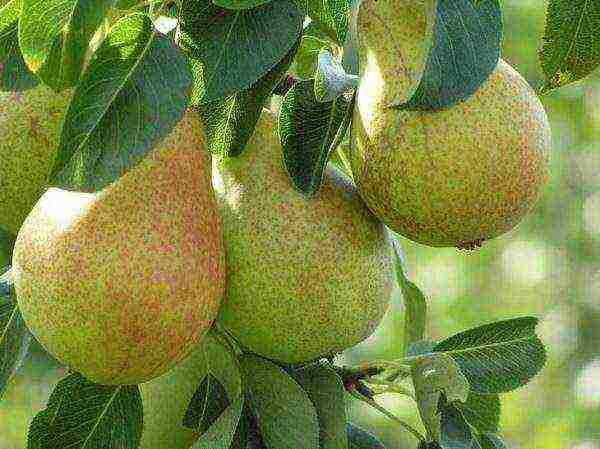 Frost-resistant pear variety Saratovka
Frost-resistant pear variety Saratovka
Saratovka is a medium-sized variety, the branches look straight up, the tree is more than 10 m high... The crown is dense, the trunk is brown-gray. Young leaves of light green color, oval, with smooth edges. By the fall, they are painted in dark green tones. The disadvantage is the dense crown, which needs proper pruning every year, otherwise, the tree reduces the amount of harvest, more energy is given to the formation of young shoots.
The yield is high, but the tree begins to bear fruit only in the 5th year. The fruits are sweet, firm, with a thick skin, lemon color, with a red-orange blush. It begins to ripen from mid-August, remains on the tree for a long time, until the end of September. The variety is winter-hardy, rarely exposed to diseases and pests, also tolerates long-term transportation, does not lose taste and external qualities.
Kondratyevka
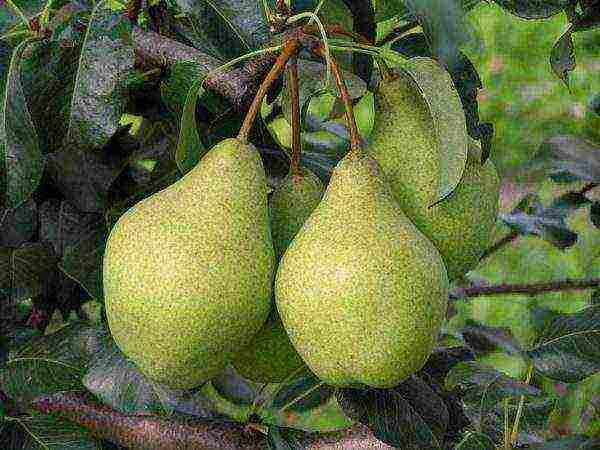 High-yielding pear variety Kondratyevka
High-yielding pear variety Kondratyevka
Winter pear variety, fruit ripening occurs in early and mid-September. High yields start from 5 years after planting. Gives a bountiful harvest annually, the tree does not need rest. The mass of one pear reaches up to 230 grams... The fruits are sweet, juicy, with delicate pulp and spicy aroma. They have the correct pear-shaped shape and are attached to a thick curved stalk. They are green when ripe, slightly yellowish.
The tree itself is quite tall, 10-12 m in height, with a pyramidal trunk and slightly drooping branches. The variety differs from others in its slow growth, it mainly builds up green mass. But then it bears a large number of fruits. Survives severe cold quite easily, tolerant of various diseases and pests.
Pass-Krasan
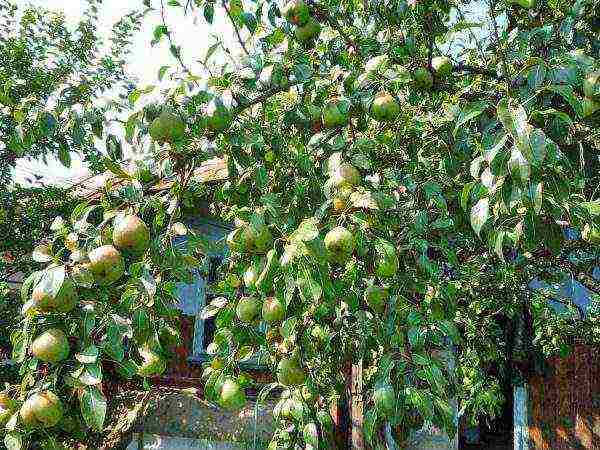 Pass-Krasan pear requires a lot of sunlight
Pass-Krasan pear requires a lot of sunlight
The same applies to winter varieties of pears. Unlike other varieties that do not need special conditions, this hybrid requires increased attention. Prefers to grow only in sunny places, does not tolerate close proximity to other seedlings. From a lack of sunlight, its fruits become sour and do not reach the required size... He also loves moisture and well-fertilized soil. It is extremely cold and susceptible to many diseases.
But subject to all conditions, it gives large, juicy fruits with a slight sour taste. It bears fruit annually, does not require rest, but you should not expect a large amount of harvest from this variety. The mass of one pear can reach more than 200 grams, large pears are light green in color. The right time to harvest is mid to late October, by this time the fruits reach their optimal size and retain their taste. The advantage is the ability of the fruit to last until next spring.
In order for the variety to begin bearing fruit earlier, it is better to graft young seedlings on quince.
May Day
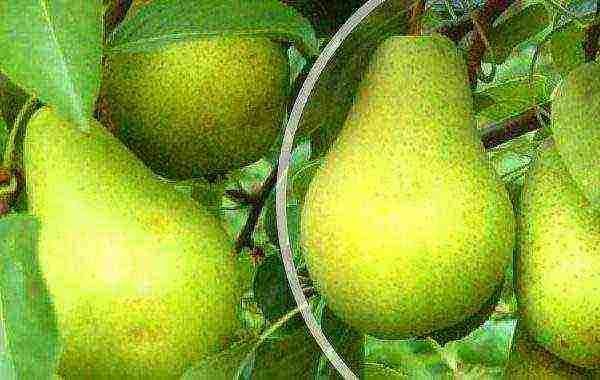 The fruits of the Pervomayskaya variety can last up to 8 months.
The fruits of the Pervomayskaya variety can last up to 8 months.
The result of crossing pears Daughter of Dawn and Late. This variety differs from others in the storage duration of the plucked fruits, up to 250 days! The pear is not demanding to care for, it is frost-resistant. She rarely gets sick, she doesn't care about many pests. The height of the tree is more than 10 m, with a spreading crown... Young shoots are rather thin, gray-brown, smooth. The leaves are round in shape, with smooth edges, slightly curved upwards.
Average fruit weight from 140 grams, have the correct shape, smooth and thin skin. During the summer, the fruits are green, towards autumn they acquire brown-red tones. Attached to branches with a strong stalk, forming a cluster of 4-6 fruits. Sweet to taste, with a pleasant aroma, slightly tart, with white pulp, has an attractive appearance and taste. The variety has a high yield, but fruiting begins at 5-6 years.
Lyre
 Pear Lear
Pear Lear
Winter variety, with a high storage capacity of fruits, up to several months. A tree with a wide pyramidal trunk, light brown in color. Branches of medium thickness, most often gray, smooth. The leaves are elongated, smooth, of dark green shades.
Pear weight more than 200 grams, fruits of greenish tones, acquire a yellowish tint. They have an elongated fruit shape, with a smooth and thin skin. Harvesting can begin from September. The pear is sweet to taste, with white juicy pulp. The yield is high, the tree does not need interruptions, but the harvest begins to appear only 4-5 years after planting. Resistant to diseases and pests, but has an average winter hardiness. Especially young seedlings need additional shelter for the winter.
Patriotic
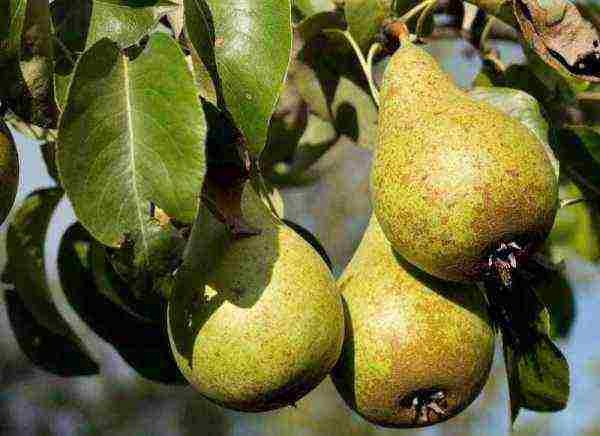 Winter variety of pears Patriotic
Winter variety of pears Patriotic
The result of the joint work of O.S. Kharchenko, A.V. Krasovsky and A.F. Mileshko. Blooms in late spring, white rounded flowers with a light aroma. The tree itself is tall, more than 10 m, with a spreading crown, straight branches. The trunk is brown, smooth, regular in shape.
Fruits are large, light green in color, more yellow when fully ripe. Fruit weight up to 180 grams, has an attractive view for sale, also protects the view during long-term transportation. It is recommended to harvest the tree in early October, the fruits can be stored for several months in a cool place. It produces crops regularly, the tree rarely gets sick and is almost not damaged by insects. It is also frost-resistant and does not need special care, it tolerates scab and thermal burns of leaves. Ripe fruits are stored for several months.
For pears to be stored longer, it is important for them to provide the necessary conditions.The fruit must not be damaged or dented when harvested. Also, the pear should be dry and wrapped in newspaper or paper. It is better to store in small boxes, in 2-3 rows. The room should not be damp, too hot and humid. The optimum storage temperature is + 8-14 degrees, in a dark place.
Late
Dessert Rossoshanskaya late
 Rossoshanskaya - pear with fruits of autumn ripening period
Rossoshanskaya - pear with fruits of autumn ripening period
Belongs to late varieties, ripening of fruits comes at the beginning of September. Dessert pear can be stored until January under proper storage conditions.... A hybrid, the result of crossing the varieties Lyubimitsa Klappa and Tonkovotka, bred in 1952. The tree is vigorous, more than 6 m in height, the seedling has a narrow pyramidal trunk, gray in color, an adult tree forms a wide and smooth trunk. The crown of the pear is branched, young branches are gray, looking up.
The fruit is large enough, weighing up to 180 grams, dark green tones at the beginning of ripening and brown-red shades by autumn. Fastened on branches of 6 pieces on thick stalks. Harvesting begins at 3 - 4 years, the yield percentage is high. Sweet to taste, with soft skin and juicy pulp.
Belarusian
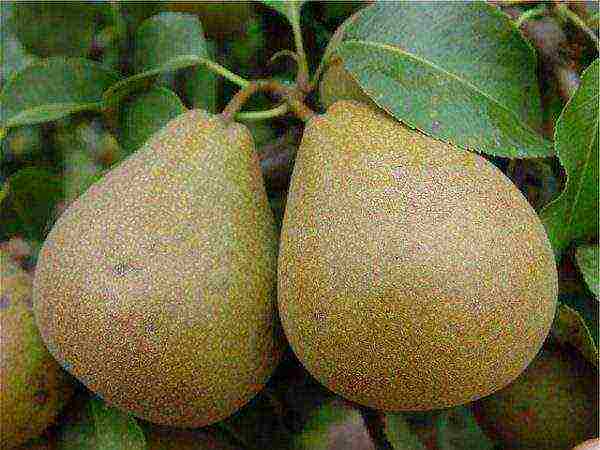 Pear Belarusian late
Pear Belarusian late
Bred in Belarus. The variety is late, ripening at the beginning of September. Small tree, no more than 3.5 m in height, branches look straight up, the crown is gray-brown, smooth. Leaves are light green, oblong in shape, with uneven edges. Flowering occurs at the beginning of spring, the inflorescences are white, with a pleasant aroma.
Fruits are dull, light green in color, changing to orange-red shades during the summer. The peel of the pear is rough, rather dense, with small black spots. The stalks are short, the pear is squeezed onto the branches in pairs. The pear tastes fleshy, with white flesh, juicy, has a slight sourness... The pear is winter-hardy, not subject to pests and diseases. Minus - it does not bear fruit every year, it needs rest.
Variety
Belarusian
is not always capable of pollinating on its own, therefore, in order to have a successful harvest, it is recommended to plant additional pollinated varieties on the site, for example,
Conference
or Bere loshitskaya.
Olivier de Serre
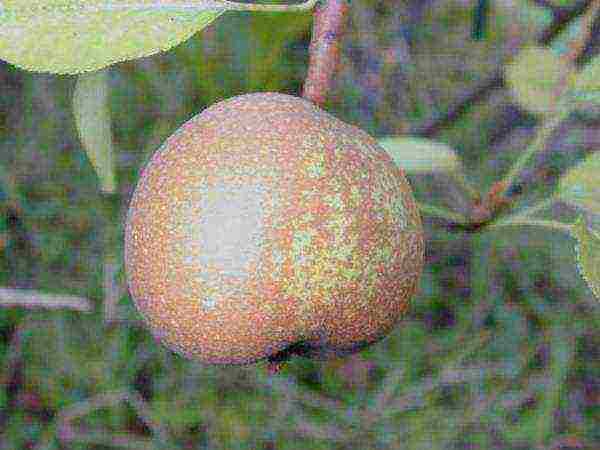 Olivier de Serre
Olivier de Serre
The work of a French breeder. The variety is quite capricious, requires special conditions for growth and careful care. The tree is medium-sized, the crown is compact, the branches are directed upwards. Crown of brownish shades, smooth, slightly flaky... During the summer, it forms many new branches, which reduces the yield, so it is important to remove excess branches in the fall. The leaves are shiny, dark green, rounded.
Fruits can weigh more than 400 grams... In appearance, the fruits are small, round in shape, with a thick skin. The whole fruit is covered with red spots, the surface is bumpy, uneven. The pear is sweet, with white fleshy pulp and a light pleasant aroma. The pear ripens by September and is stored harvested until spring. It is resistant to diseases, but in severe winters it needs additional shelter, otherwise the amount of harvest in the next year decreases.
Bere Ardanpon
 Pear of late ripening Bere Ardanpon
Pear of late ripening Bere Ardanpon
It was bred in Belgium by N. Ardanpon in 1759. This winter-hardy undersized hybrid requires special care. It prefers to grow in the sun, heat and well-moisturized soil - only under these conditions does the tree bear fruit. The tree is vigorous, with a dense crown of brownish-gray color... Young branches are thin, not lowered, The leaf blade is pointed, dark green in color, slightly pointed in shape. Blooms in early spring, with white fragrant inflorescences.
Fruits are large, green in mid-summer and reddish when fully ripe closer to autumn. A pear with a thin, smooth skin. This variety fell in love with gardeners because of its attractive presentation., which persists until cold weather. The pear is sweet to taste, with white, fleshy flesh.It tolerates winter firmly, but it is better to cover young seedlings.
Hera
 The Gera variety is famous for its large fruits.
The Gera variety is famous for its large fruits.
The same applies to winter varieties, which appeared as a result of crossing Reale Turin and Daughter of the Dawn. The variety is not particularly different from others, but because of its large fruits, it fell in love with gardeners. One pear can weigh up to 280 grams! In addition, the fruits have light green hues, which change to reddish during the ripening process. Not inferior in taste, pears are sweet, with fine-grained cream-colored pulp. They have a delicate, slightly sour taste, with a pleasant aroma.
The tree is medium-sized, no more than 6 m high, with spreading branches, crown, brownish color. Able to give a large amount of harvest annually, not picky about conditions and care. Plucked fruits can be stored for several months. In addition, the variety is quite resistant to diseases, not afraid of insects, frost-resistant.
In ancient Greece, pear fruits were used as a remedy for nausea.
Miracle woman
 Pear Miracle
Pear Miracle
Another winter pear, a hybrid obtained by crossing the Daughter of Zarya and Talgar beauty varieties. Possesses excellent resistance to frost and disease... Has a pyramidal crown, no more than 5 m high. The branches are thin, look up, gray-brown in color. The leaves are rounded, dark green in color, small light streaks are clearly visible. Blooms in early spring, white fragrant inflorescences.
High yield variety, by weight one fruit from 140 to 210 grams, can remain on the tree for a long time and can be stored for a long time when assembled. Fruits are light green in color; towards autumn they become yellowish, slightly elongated. Sweet to taste, with fleshy pulp, have a delicate pleasant aroma.
Autumn
Autumn garden varieties differ from others in the long term storage in assembled form, they are not inferior in taste to summer or winter ones.
Veles
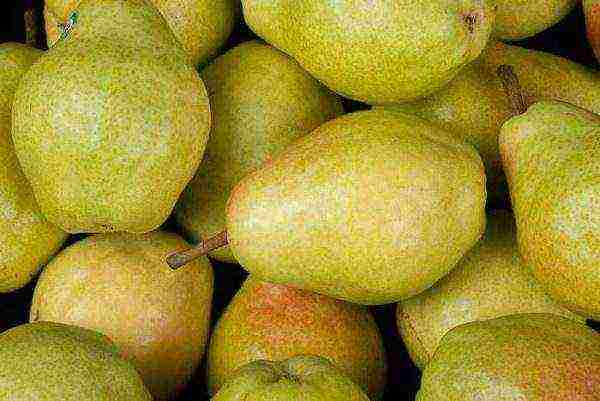 Veles pear variety
Veles pear variety
Autumn pear variety, one of the best. The fruits are large enough, the average weight of a pear is from 150 grams and above... Fruits are regular pear-shaped: narrow at the stalk and rounded at the bottom. On the branches they grow in small clusters, 3-4 pears each. The Veles pear ripens at the end of August, remains on the tree until October. It has a beautiful appearance, until the end of summer, the fruits are dark green, and when ripe, they become red-orange tones. The taste is sweet, juicy, with fleshy pulp and thin skin.
The height of the tree is no more than 8 m, with drooping branches and a pyramidal shape of the trunk, gray-brown in color. Young branches are formed throughout the summer, which affects the amount of the harvest, it is recommended to prune in the fall. Resistant to frost, disease and pests.
Bere Moskovskaya
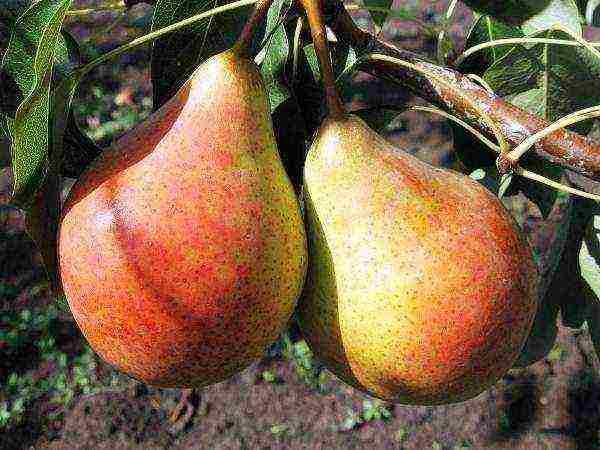 Bitter-tart pear varieties Bere Moscowskaya
Bitter-tart pear varieties Bere Moscowskaya
Frost-resistant, almost not exposed to diseases and pests. It appeared as a result of pollination of the Olga variety with pollen from the Lesnaya Krasavitsa and Lyubimitsa Klappa varieties. A tree no more than 6-8 m high... The crown of the pear is round, light brown in color. Young branches are rather thin, drooping, gray or brown in color. The leaf plate is dark green, rounded. The pear blooms in early spring.
Fruits are slightly bumpy, light green shades, there is a slight blush closer to autumn.It is best to remove fruits that are slightly green and firm in early autumn., so they keep better and stay longer, up to several months in a cool and dark place. If the pear tastes slightly tart, with sourness, it means that the pear lacks moisture. With proper care, the pear becomes sweet and fleshy, with a delicate white flesh. In general, this variety is not capricious when leaving.
Red-sided
 Pear variety Red-sided
Pear variety Red-sided
The misconception that this variety belongs to the winter, it is not, the variety is autumn ripening. It was obtained as a result of crossing the varieties Zheltoplodnaya and Tenderness. Resistant to diseases and pests, especially scab... It is frost-resistant, gives a good harvest from year to year. The crown is rounded, the branches are slightly drooping, brown-gray in color. Leaves are slightly pointed, light green shades in spring and dark green tones closer to autumn.
Does not require special care, can grow in small shade, under taller trees, but loves moisture. Fruits of medium size, weighing no more than 200 grams... Green pears change their shades to a raspberry blush as they ripen. Sweet to taste, with juicy fine-grained pulp and thin skin. Stick to branches, on short, curved stalks. The fruits are able to survive for a long time, both on the tree and in the harvested state, they are not afraid of transportation.
In memory of Yakovlev
 Pear variety of high winter hardiness in Memory of Yakovlev
Pear variety of high winter hardiness in Memory of Yakovlev
A medium-sized tree with a dense crown. The height of the tree does not exceed 1.5-2m, with a spherical crown. Young branches are thin, looking up, brown-gray in color with small thorns. The leaves are dark green, ovoid, with smooth edges. The harvest gives for 6-8 years... The Pamyati Yakovlev variety is popular among gardeners due to regular fruiting and unpretentious care.
Pears with smooth and thin skin, weighing no more than 200 grams. The fruits are collected in groups of 5-7 pears. The pear is sweet to taste, with juicy pulp and pleasant aroma. The fruits are golden in color, slightly reddish at the end of ripening. Full ripening of fruits occurs in mid-October.... The pear is stored on the tree for a long time, does not fall off, and in the assembled state it can lie for several months. High yield, which increases every year the tree grows. More than 30 kg of ripe pears are harvested from an adult tree per year. In addition, it is capable not only of self-pollination, but also pollinates other varieties of pears. It greatly simplifies the care of a pear that it is winter-hardy and unpretentious in care.
For the first time the word "pear" was mentioned in chronicles in the 12th century, and sounded like "hrusha". And all because of the characteristic crunch that was published when the fruit was bitten.
Muscovite
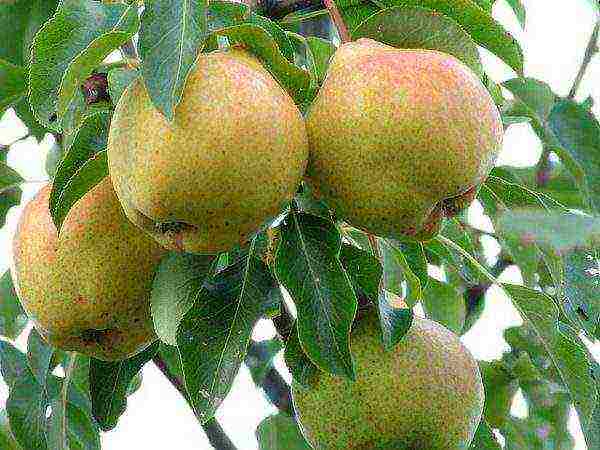 Branch of pear Moskvichka with fruits
Branch of pear Moskvichka with fruits
Obtained as a result of pollination of one of the American Kieffer pear varieties. Possesses a standard shape, with a rather dense and spreading crown, light gray colors, which eventually changes shades to brown tones. Forms new curved shoots quickly. The foliage is light green in color, with an oval shape, slightly curved in the center. This variety produces a bountiful harvest in the southwestern regions. The first harvest is formed in 3-4 years.
Muscovites are medium-sized fruits, up to 150 grams. They have the correct pear-shaped shape. They have a greenish-yellow hue, which changes towards burgundy-crimson tones by the end of summer. The skin is thin, fleshy with a juicy pulp with a pronounced sweet-sour taste. It is recommended to pick pears when they are slightly underripe, because after lying in the room for a couple of days, the pear ripens and retains its taste. Under the right storage conditions, the fruits are able not to spoil for several months.... High resistance to scab and rot, also not afraid of frost.
Marble
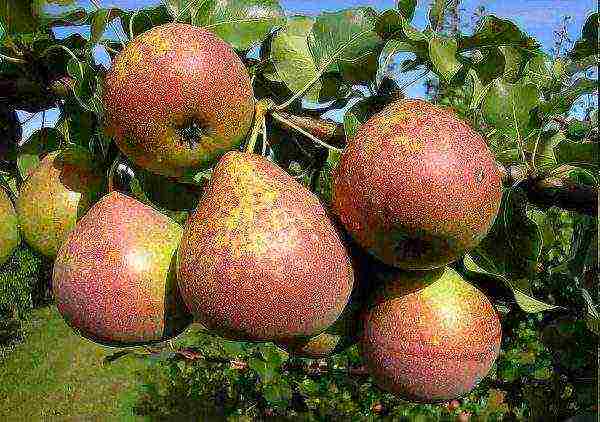 Marble pear fruits
Marble pear fruits
The fruit of the crossing of Bere Zimnaya Michurina and Lesnoy Krasavitsa varieties. The harvest of this variety ripens by the very beginning of autumn, the first fruits can be picked at the beginning of September. Differs from others in the height and density of the crown, the height of the tree is more than 8 m... Many light brown thin branches are formed every year, but pear shoots are extremely rare. Blooms in early spring with white fragrant inflorescences. The foliage is dark green in color.
The fruits are large, from 170 grams, with yellowish-green hues and a slight blush. The pear is also distinguished by the correct conical shape of the fruit. The pulp is coarse, tender, juicy. Rather dense rind, with small dots of a rusty color. The Marble variety, like other autumn pears, is frost-resistant, not afraid of diseases and pests. The tree begins to yield only 5 years, but the yield percentage is high, the pear is able to please with a large amount of harvest every year.
Pear for the Volga region and central Russia
Chizhovskaya
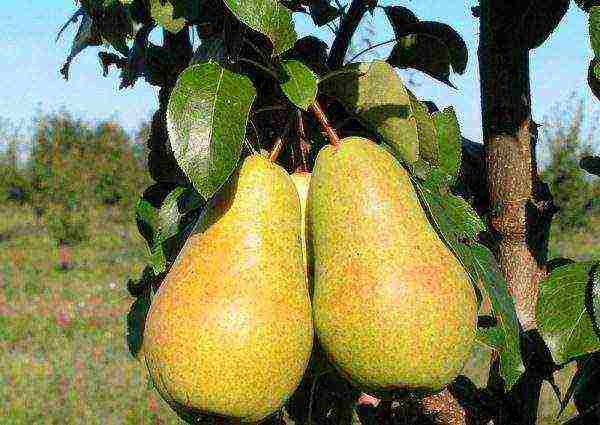 Winter-hardy pear Chizhovskaya
Winter-hardy pear Chizhovskaya
Olga and Lesnaya Krasavitsa were taken as the "parental" varieties, as a result of the long work of S.T. Chizhov and S.P. Potapov and the Chizhovskaya variety was bred. One of the popular self-pollinated varieties in the middle lane, especially in the Volga region and surrounding areas... The tree is no more than 3 m high, the young tree has a narrow crown, grayish shades. Older branches acquire a brownish color, branches look up, medium in thickness, slightly curved. Leaves are oval, dark green in color with smooth edges.
By themselves, the fruits weighing no more than 150 grams. At the beginning of summer, the pear is of light green tones, the fruit is quite hard, but closer to autumn it acquires yellow shades and becomes soft. In this state, the Chizhovskaya pear will not hang on the tree for a long time, therefore it is recommended to pick it at the beginning of autumn. Green fruits can last for several weeks.... Sweet and fleshy on the palate, ripens in mid-August. They have a white, medium-grained pulp with a pleasant aroma. In addition, she inherited frost and disease resistance from her relatives.
The peculiarity of the variety is that the older the tree, the smaller the fruits. You can fight this with timely pruning.
Lada
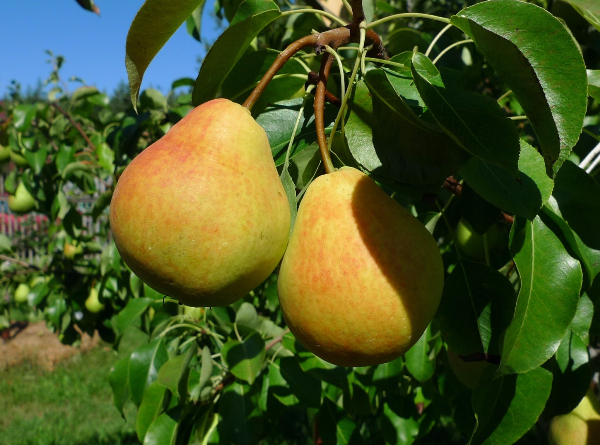 Pear Lada belongs to the early summer varieties
Pear Lada belongs to the early summer varieties
The result of crossing the varieties Lesnaya Krasavitsa and Olga, a variety suitable for planting in the middle lane. Differs in early maturity of fruits, you can taste fresh fruits already in the middle of summer... Lada is frost-resistant, is not susceptible to diseases and pests, and gives a rich harvest every year. A tree with a branchy crown, branches slightly drooping, looking down. The height of the tree is not more than 3 m, with a pyramidal trunk, closely gray in color. Leaves are shiny, smooth, dark green tones. It winters well enough even in the most severe winters, is resistant to diseases, partially self-fertile.
Medium-sized fruits, no more than 100 grams, light green tones with thin skin. Closer to ripening, the fruits give in yellow tones, become soft to the touch. It is important to take the moment to remove the fruits from the tree, otherwise they become soft, covered with rusty spots and fall off. The fruit is attached to the branches in pairs on short stalks. It tastes sweet, with a slight hint of sourness and can be stored for a long time when torn off, especially in a cool place.
Bessemyanka
 Pear Bessemyanka belongs to high-yielding varieties
Pear Bessemyanka belongs to high-yielding varieties
Popular and quite interesting for planting, especially spread in the Central regions, it also grows well in the middle lane. The tree is vigorous, growth rates are fast, yields stable, does not need rest. The yield is high, more than 50 kg of fruits are harvested per year. The tree is more than 6 m high, with spreading and curved branches. The leaves are oval, dark green in color, with rounded edges. The variety is also resistant to frost, but prone to scab and other diseases.
Annually it pleases with a large amount of harvest, although the fruits are rather small, more like apples. Light green in color, firm when ripe, the fruits turn yellow and soft when ripe. Attached to branches, one fruit on short stalks. Ripening occurs at the end of summer, when the fruits become yellowish.... Does not last long on the tree, quickly falls off. In addition, it does not lie for long and in a torn form, no more than 2-3 weeks.
In Europe, until the moment when tobacco was introduced, crushed pear leaves were used for smoking.
Skorospelka from Michurinsk
 Pear Skorospelka from Michurinsk
Pear Skorospelka from Michurinsk
This variety breaks all records for the speed of fruit ripening. Bred by IV Michurin, as a result of crossing the varieties Citron de Carme and Bere Ligel. It belongs to the early varieties of pear, the harvest ripens by the middle of summer... It is a tall tree, the shape of the trunk is pyramidal, light brown in color.
Fruits no more than 90 grams, green in summer, acquire a yellow tint when fully ripe. Small fruits are offset by taste: sweet, juicy, this pear is loved not only by gardeners, but bees and birds. Therefore, it is better to collect them when they are a little hard, they are stored for no more than a week. The tree itself is winter-hardy, with a dense crown, resistant to diseases and pests.
Allegro
 Pear variety for the middle Allegro strip
Pear variety for the middle Allegro strip
Bred thanks to artificial pollination of the Osennyaya Yakovleva variety. Another variety for the middle lane, which bears fruit annually, is unpretentious in care, resistant to disease and severe cold. Fruiting begins at the age of 3 years, over time, the fruits become larger in size. Medium-sized tree, more than 5 m high, with a lowered crown. The branches are curved, light gray, the leaves are slightly elongated, closely green in color.
A pear weighing from 120 grams with a thick skin, but juicy and sweet pulp, with a spicy aroma. Correct pear-shaped, slightly elongated fruits. They are attached to the branches with a thick stalk, grow on a branch one by one. Ripening occurs at the beginning of August., the fruits turn yellowish-red and become soft. The variety is not stored for a long time, ripe fruits hang on the tree for no more than 2 weeks, but when assembled they can lie for more than a month.
The middle zone of Russia has a special climate that is not suitable for growing all varieties of pears. There are pronounced hot summers, severe winters, and transitional periods with a lot of precipitation. Only those who “love” this weather can grow and bear fruit here, and proper care will ensure a greater pear yield.
Garden varieties for the Moscow region, description
Prominent or Bumpy
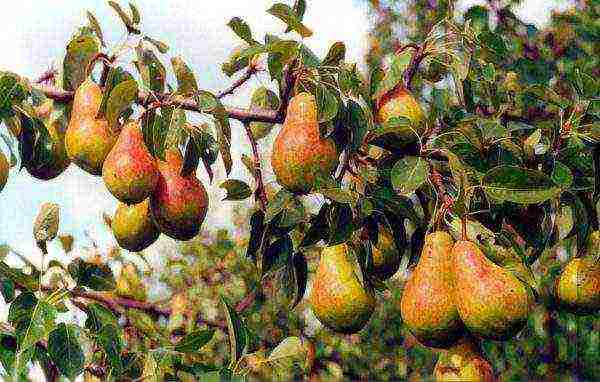 Pear variety Bumpy
Pear variety Bumpy
A pear variety that has long been loved by the Moscow region. A tree no more than 5 m high, with a fairly spreading young crown, which subsequently takes on a pyramidal shape. During the summer, the tree forms many young branches, which must be cut in the fall, otherwise the fruits will become smaller. The leaf plate is elongated, with light streaks, dark green in color. Blooms in early spring, many white inflorescences with a pleasant aroma.
Fruiting begins in the 5th year, fruits of medium size, regular pear-shaped. The color is greenish-yellow during the summer, with a red tint closer to autumn. Fruits with thick skin and coarse white flesh... Sweet and juicy on the palate, with a pleasant aroma. When harvested, they can last for several months, but it is recommended to harvest the fruits in mid-August, when the fruits are quite hard and slightly underripe.
Tenderness
 Hybrid variety Tenderness
Hybrid variety Tenderness
The variety obtained as a result of crossing Tyoma and Lyubimitsa Klapp. A particularly large amount of crops gives in the Volga region, the middle lane and in the Moscow region... The tree is medium-sized, no more than 4 m in height, with a sparse crown. The branches are thin, light gray. The tree blooms in mid-spring, white, small inflorescences. The leaves are round, with smooth edges, smooth. Frost-resistant, capable of bearing fruit annually. It prefers to grow in sunny areas, is resistant to diseases, is not afraid of pests, so growing this variety will not be difficult.
Fruits are large, weighing more than 200 grams with a regular pear-shaped fruit... The pear tastes soft, juicy, coarse-grained with a pleasant aroma. Attached to branches with short stalks. In the middle of the fruit is a chamber with brown seeds. The fruits of this pear are preserved for a long time both on the tree and in the harvested form, especially at a temperature of 0 degrees.
The pear tree is not capable of deforming, which is why, for example, rulers for architects are made from it.
Fabulous
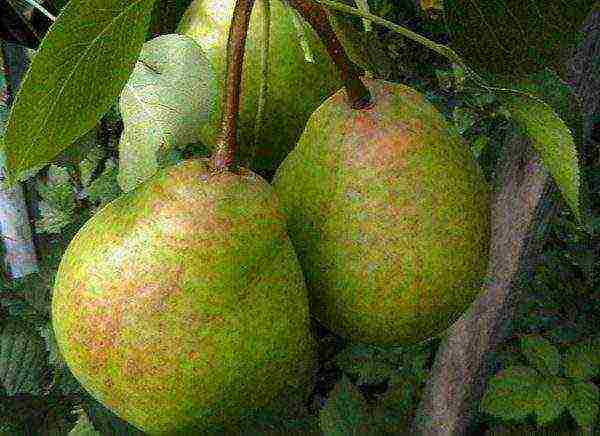 Pear Fairy is characterized as a tall and very productive variety.
Pear Fairy is characterized as a tall and very productive variety.
It got its name from the beautiful fruits. Obtained as a result of crossing the varieties Powislaya and Tenderness.The pear has a high yield, more than 30 kg of ripe fruits are harvested from one adult tree per season... The height of the tree reaches 4 m, the branches are dense, thin with a gray-brown crown. The leaf plate is smooth, rather small, of green shades, with small teeth along the edges.
When the pear ripens, it becomes yellow-reddish on one side and greenish on the other. Has the correct shape of the fruit, moreover one pear can weigh over 150 grams... The pulp of the pear is white, fleshy, medium-grained. In the center of the fruit are chambers with dark brown seeds. It tolerates diseases steadily, is not afraid of frost, seedlings easily take root in a new place.
Vera Yellow
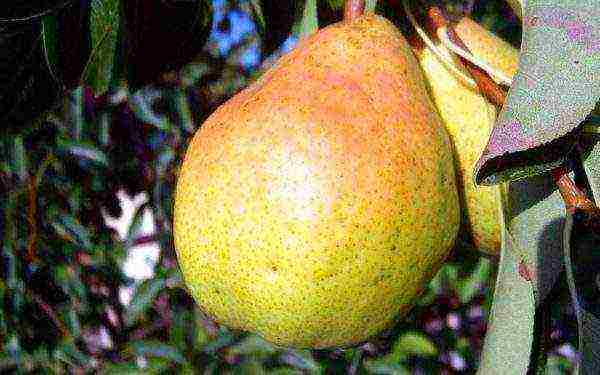 Vera Yellow
Vera Yellow
Another suitable variety for planting in the Moscow region. A tree with a height of more than 6 m, with a pyramidal shape of the trunk, with erect branches of a brown-brown color... Young leaves of light green tones, by autumn change color to dark green shades. Frost-resistant, does not need special care. The pear ripens in mid-September. It differs from others in that it has declines in yield, the fruits become smaller, but after a couple of years the pear again pleases with a large harvest.
Fruits have green hues throughout the summer, but change to yellow-orange colors closer to autumn. Fastens on short stalks, grows 2-3 pears in a bunch... To the taste, the pear is fragrant and fleshy, medium-grained pulp with a thin skin. Good storage capacity, especially in a cool place.
Elegant Efimova
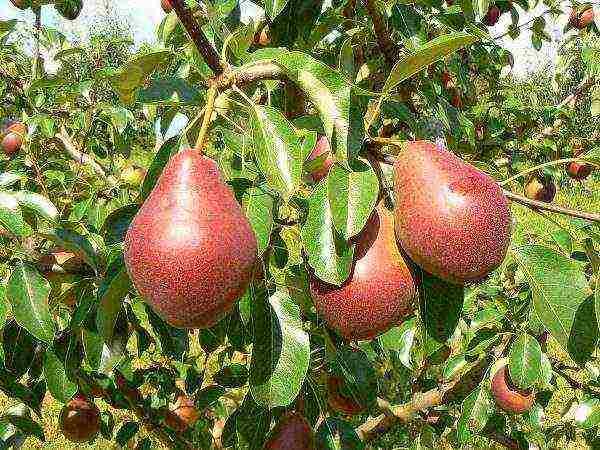 Variety Dressy Efimova
Variety Dressy Efimova
It turned out as a result of crossing the varieties Lyubimitsa Klappa and Tonkovotka. It grows well and gives a rich harvest in the Central Region, the Moscow Region and other nearby regions. High-yielding, winter-hardy, not subject to pests and diseases... The tree is tall, more than 5 m in height, with a dense crown, dark brown, pyramidal in shape. The leaves are small, dark green in color, with smooth edges.
Beautiful fruit appearance, red-orange tones are intertwined with green shades. But the fruits are small in size, weighing no more than 120 grams, regular, slightly distant shape. Soft, juicy pulp with a pleasant sweet aroma. The thin skin of the pear is prone to dark spots during the summer. Fruits ripen at the end of August, overripe quickly, so it is better to collect them a little hard, and it is recommended to store them in a cool and dark place.
Venus
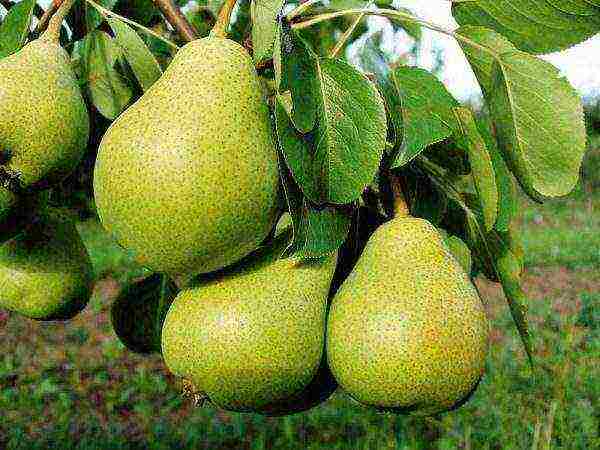 Pear venus
Pear venus
Another popular variety for planting, due to its winter hardiness and unpretentious care. Tree no more than 4m high, the crown is quite spreading, young branches are slightly lowered down, light brown in color. The variety blooms in early spring with white inflorescences with a sweet aroma. The variety also differs in high productivity, an adult tree is capable of producing more than 40 kg of harvest over the summer. Does not need rest, is able to bear fruit annually. In addition, the variety tolerates frosts, diseases and pests quite steadily.
The variety ripens in early autumn, the fruits are large, weighing up to 200 grams... Red-yellow in color, green tones when ripe. The taste is soft, juicy, slightly sour with a thin skin. They are stored for a long time both on the tree and when assembled.
Regardless of the specific variety, of which there are a huge variety today, the main thing in a pear is its taste and useful microelements, which are so abundant in ripe fruits. Winter, summer and autumn varieties differ from each other not only in taste, but also in the speed of fruit ripening., features of care, and the ability to preserve the fruit. Which variety to choose is up to you.
Do you want to feast on delicious, juicy, aromatic pears all year round? By planting trees of early, medium and late varieties on the site, you will provide yourself with ripe sweet pears for the entire summer season.
Surprisingly, very often, truly delicious pears are not very beautiful in appearance. Conversely, the fruits of most varieties, which look like they can be sent straight from the branches to the shelves, often do not differ in special taste. This article will help you understand the variety of tastes and forms.
August dew
High-yielding variety of summer ripening period. Pear trees of this variety are considered undersized and even dwarf. They tolerate frost well down to –25 ° C and are resistant to diseases. The fruits ripen juicy, sweet with a slight sour accent and white, fine-grained, delicate taste pulp. Pears are harvested still green, but after ripening they acquire a green-yellow tint with a slight blush. Fruits that have reached maturity do not fall off.
|
Entering fruiting |
Tree height (m) |
Fruit weight (g) |
Harvest |
Shelf life (days) |
|
2-3 years |
2,5-3,5 |
Mid august |
10-14 |
|
Veles
Frost-resistant pear variety. The tree is medium-sized, with a spreading crown. Fruits are symmetrical with a smooth surface, greenish-yellow with an orange tint. The pulp is creamy, semi-oily, juicy, sweet and sour. These pears are great for fresh consumption.
|
Entering fruiting |
Tree height (m) |
Fruit weight (g) |
Harvest |
Shelf life (days) |
|
For 5-7 years |
3-4 |
140-200 |
Mid september |
60-70 |
Duchess Summer (Williams)
A high-yielding dessert variety of pears. Fruits are fragrant, juicy, sweet, classic pear-shaped, light green when picked, turn yellow during ripening. Suitable for drying and preserving. The pulp is white or creamy, juicy, wine-sweet with a nutmeg aroma. This variety also has disadvantages. Pear trees do not tolerate frost and drought well. Plants require pollinating neighbors, such as Forest Beauty or Lyubimitsa Klappa pears.
|
Entering fruiting |
Tree height (m) |
Fruit weight (g) |
Harvest |
Shelf life (days) |
|
For 5-6 years |
3-5 |
End of August |
45-50 |
|
Clapp's Favorite
Summer high-yielding pear variety. In the southern regions, yellow fruits with a reddish blush ripen at the end of July. The skin of the ripe fruit is smooth, the flesh is white, tender, juicy, aromatic, sweet with a sour taste. When ripe, the fruits quickly fall off and are not stored for long. It is a self-infertile variety, but in the vicinity of Duchess Letniy it will be able to fully “realize” its potential.
|
Entering fruiting |
Tree height (m) |
Fruit weight (g) |
Harvest |
Shelf life (days) |
|
7 year |
3-4 |
180-230 |
Early august |
10-15 |
Muscovite
A productive variety, perfect for growing in the middle lane. The trees are medium-sized, winter-hardy, but they are afraid of drought, due to which the yield decreases and pears fall. The fruits are wide, yellow-green in color, often with abundant rustiness. The pulp is white or creamy, coarse-grained, juicy, melting.
|
Entering fruiting |
Tree height (m) |
Fruit weight (g) |
Harvest |
Shelf life (days) |
|
For 6-7 years |
3-4 |
140-200 |
Mid september |
60-70 days |
Olivier de Serre
Winter variety of pears. The fruit looks like a flattened ball with tubercles. The view is not very presentable, but the taste is excellent. The pulp is sweet with a hint of almonds, very juicy, but at the same time quite dense. The fruits are ideal both for fresh consumption and for storage, transportation, conservation.
|
Entering fruiting |
Tree height (m) |
Fruit weight (g) |
Harvest |
Shelf life (days) |
|
For 6-7 years |
3-4 |
Early October |
140-160 |
|
Simply Maria
High-yielding winter-hardy pear variety. The tree is medium-sized. The fruits are pear-shaped, green-yellow in color with a slight pink blush. The skin is thin and dry, the flesh is yellowish-white, oily, fine-grained, sweet and sour with a weak aroma, very tasty. The variety is resistant to a complex of diseases.
| Entering fruiting | Tree height (m) | Fruit weight (g) | Harvest | Shelf life (days) |
| 3 year | 2-3 | 200 | October | 90-100 |
Every gardener dreams of growing a good harvest of delicious pears on his site. Using the information from our article, it will not be so difficult to do this.
The best varieties of pears in the video.
The most significant contribution to the development of new varieties of pears of Russian selection was made by the famous biologist and botanist, director of the first genetic selection station IV Michurin. It was thanks to his many years of painstaking work that such delicious pear varieties as Sugar Surrogate, Bere Zimnaya, Tolstobezhka and many others, adapted for the average Russian climatic conditions, were obtained.
After IV Michurin, little was involved in the selection of pear varieties for central Russia and other regions, since gardeners were frightened by the length of the process: pear seedlings often begin to bear fruit in the 12th and even 30th year after sowing. And at the experimental stations, breeders gave preference to the apple tree. Nevertheless, to date, especially over the past 30 years, new promising pear varieties have been created.
This page contains photos, names and descriptions of the best pear varieties for Russian regions.
Early varieties of summer pears for the middle lane: photo and description
August dew.
The summer variety was obtained by S.P. Yakovlev at the All-Russian Research Institute of Genetics and Breeding of Fruit Plants. IV Michurin from crossing a donor of high winter hardiness and a source of complex disease resistance (variety Tenderness x Australian variety Triumph Pakgama). It is becoming more widespread due to a complex of valuable economic and biological characteristics.
The tree is small, fast-growing, with a slightly drooping, medium-dense crown. Differs in high kidney awakening and shoot-forming ability. The bark on the trunk and skeletal branches is smooth, gray. Branches branch off almost at right angles. The predominant type of fruit formations is ringlet, spear.
Shoots are thick, geniculate, curved, light brown, many lentils, small. The kidneys are bent, conical, medium. The leaves are medium, oblong - ovate, short-pointed, dark green, shiny, the base is wedge-shaped, the blade is directed upward, the edge is serrate. The petiole is of medium length and thickness, the internodes are medium. Stipules are saber-shaped, small.
As you can see in the photo, the fruits of this pear variety are of medium size, rather one-dimensional, short-pear-shaped, without ribs:
Coloring at the moment of ripening: the main green, the integumentary is absent, During the period of consumer maturity, the main is greenish-yellow, the integumentary is very weak blush on the smaller part of the fruit, there are many subcutaneous dots. The skin is smooth and dull. The peduncle is long, thick, curved. The funnel is shallow, blunt-conical. The cup is small, closed. The saucer is small, wide, slightly ribbed. The heart is large, bulbous. Closed cameras, medium. The subcapillary tube is short, wide, cupped. There is a slight rustiness at the funnel. The pulp is white, fine-grained, juicy, sour-sweet taste, tender. The fruits stick firmly to the tree and ripen in mid-August, the period of consumption and storage is up to two weeks. The marketability of fruits is high. The fruits are mainly for table purposes.
This summer pear has a low self-fertility rate. The best pollinator is in Memory of Yakovlev. However, it gives a good harvest when pollinated with the Lada variety. Trees begin to bear fruit 4 years after planting in the garden, fruiting is annual. Winter hardiness is high. Fruits and leaves are not affected by scab. Advantages of the variety: early maturity, high winter hardiness, yield, marketability of fruits, resistance to the most common fungal diseases.
The disadvantage of this variety of pears of early ripening is that with a bountiful harvest, there is some unevenness in the fruit.
Academic.
A new promising variety of late summer or early autumn ripening. Bred at the Moscow Agricultural Academy (MCAA).The tree has a spreading crown and a restrained vigor.
Pay attention to the photo - in this summer pear variety, fruits weighing up to 150 g have a cover color in the form of bright carmine stripes of various thicknesses:
The pulp of medium density, dessert taste, after storage acquires a well-perceptible aroma and caramel flavor.
Bashkir large.
A variety of late summer or early autumn ripening. Trees of medium size and medium density, wide pyramidal shape. Shoots are thick, geniculate, reddish-brown. Leaves are broad-ovate, long-pointed, dark green with a bluish tinge. The leaf blade is curved downward and slightly folded along the central vein. The edge of the leaf is almost smooth, wavy. The petiole is reddish brown.
The name of this variety of pears is given for the size of the fruits - they are large (130-150 g), one-dimensional, wide-round, regular in shape, green-yellow. The pulp is white, tender, fine-grained, of medium density and juiciness, good taste.
These photos show the summer varieties of pears, the description of which is given above:
Full characteristics of summer varieties of pears: photos, names and descriptions
Bashkir summer.
The variety is winter-hardy, fruitful. Crown of medium size and medium thickening, broad-pyramidal, fruiting mainly on lances and bouquet branches. Leaves are medium in size, elongated-oval, with a short-pointed apex. The leaf blade is curved downward, the petiole is long and thick. Flower buds are large, lunar.
This is one of the earliest varieties of pears with medium-sized fruits (70-80 g), oval-pear-shaped. The peduncle is of medium length and thickness. The skin is of medium thickness, smooth, dull, oily. The main color of the fruit is greenish-yellow, the integumentary color is in the form of a light tan on the sunny side. The pulp is white, fine-grained, juicy, of medium density, good sweet and sour taste, aromatic.
Seedless.
The most common summer variety of folk selection.
The tree grows relatively quickly, becoming tall with a broad-pyramidal crown of medium density. It is distinguished by its great endurance even in the conditions of the Middle Trans-Volga region, but in very severe winters it freezes underneath, quickly recovering.
Look at the photo - this early pear variety has medium-sized fruits, short pear-shaped:
Ripen in late August - early September. They keep on the tree for about a month. In case of incomplete ripening, transportation is well tolerated. The skin is green during removal; when ripe, which occurs quickly, it becomes light yellow with a cloudy dark orange blush. The pulp is light yellow, very juicy, almost melting, sweet, with some spice. The fruits are mainly used fresh; only unripe are suitable for processing. The yield is high. The variety is self-fertile, produces many fruits without seeds. The variety is resistant to diseases and pests.
Prominent (Bumpy).
Late-summer variety of selection VSTISP, obtained from pollination of interspecific hybrid VI -53-67 with a mixture of southern varieties of pollen. Authors Yu. A. Petrov, N. V. Efimova. This pear variety is suitable for the Moscow region, it is also zoned for the Central region.
The full characteristic of the pear variety Vidnaya (Bumpy) is as follows. A tree at a young age with a spreading, then pyramidal, medium-dense crown formed by powerful branches with rather large numerous ringlets, on which fruiting is mainly concentrated.
Shoots are long, of medium thickness, light brown. Leaves are medium, smooth, with raised serrated edges. Petioles of medium length and thickness with lanceolate stipules.
Fruits are of medium and above average size, elongated pear-shaped, symmetrical, with a ribbed uneven surface. The main color is greenish-yellow, the integumentary color is in the form of a light orange tan. The peduncle is of medium length and thickness, curved. The calyx is medium, closed over a short funnel-shaped sub-mucosa tube. The seed chambers are closed, with medium, elongated, brown seeds.The axial cavity is medium. This is one of the most delicious varieties of pears for the middle lane with a white, very juicy, sweet and sour pulp of excellent taste. Ripening is non-simultaneous, it is better to collect it in 2-3 doses. Ripe fruits are better preserved on the tree, after removal they are not stored for a long time. The fruits are good for fresh consumption and for processing. The beginning of fruiting at 4-5 years (from the year of growth in the nursery). Winter hardiness of trees is high, at the level of old average Russian varieties. The variety is resistant to fungal diseases.
Here are photos of varieties of early pears, the description of which is given on this page:
Children's. This variety got this name because children especially like to feast on its sweet fruits. The tree is powerful, durable. Winter hardiness at the Antonovka level.
Fruits are medium-sized (60-70 g), bright yellow with an orange blush. Ripen 10 days earlier than Papirovka, which usually opens the apple season.
Yellow-fruited. The variety was bred in YUNIIPOK. The tree is medium-sized, spreading, with a rounded crown, medium-hardy, fruitful.
Fruits weighing 110 g, large - up to 150 g, pear-shaped, yellowish-green, with a blush on the lighted side, ripen at the end of August and are stored for two weeks. The pulp is white, juicy, sweet. Pollinating varieties: Rainbow, Severyanka, Fabulous.
The main characteristic of this pear variety is its high resistance to pear gall mite and fire blight; it is not affected by scab.
Space. The variety was bred at the All-Russian Research Institute of Horticulture (Michurinsk). The variety is medium-hardy, medium-yielding. When describing this pear variety, it is worth noting that it is slightly affected by scab. It begins to bear fruit in the 7-8th year after planting. The trees are vigorous with a rounded-spreading or wide-pyramidal crown.
Fruits of medium size (70-100 g), cuboid, yellow, with a slight blurred blush. The pulp is sweet, fine-grained, of pleasant taste, for table use. The fruits ripen in the second half of August; they remain in maturation for 2 weeks.
Lada. Variety of selection of the Moscow Agricultural Academy named after KA Timiryazeva, moderately hardy, productive, relatively resistant to scab, begins to bear fruit in the 4-5th year after planting.
This is one of the best pears for the Moscow region with medium-sized fruits (110-150 g), pear-shaped, yellow. Ripen in the second half of August. Stored for up to two weeks. The pulp is semi-oily, sweet and sour taste, for table use.
Moscow. The variety was bred by VSTISP (Moscow). Medium-hardy, medium-yielding, medium-resistant to scab. The trees are medium-sized with a wide-pyramidal crown; they begin to bear fruit in the 6-7th year after planting.
Fruits are of medium size (70-100 g), pear-shaped, obovate, golden yellow. The pulp is juicy, sour-sweet, of good taste, buttery, for table use. The fruits ripen in late August-early September; they remain in maturation for about two weeks.
Look at the photos of pear varieties, the description of which is presented in this section:
Fabulous. The variety was bred in YUNIIPOK. The tree is medium-hardy, medium-sized, with a tight crown.
This is one of the best pear varieties with large, beautiful fruits with a good dessert taste, ripens at the end of summer and is stored for two weeks. The pulp is juicy, sweet. The variety is resistant to pear and gall mites and bacterial burns, and is not affected by scab.
Below you will find out which winter hardy pear varieties are the best.
What are the best winter-hardy pear varieties?
Krasulia. The variety was bred in YUNIIPOK. The tree is medium-sized, with a rounded dense crown. This is one of the most winter-hardy pear varieties, fast-growing (4-5th year), medium-yielding.
Fruits weighing 90 g, large - up to 110 g, irregular, oval-flattened, yellow-green, with a dark red blush. Ripen in the first half of August, 7 days earlier than Severyanka and stored for 10-12 days.
The pulp of the fruit is creamy, friable, fine-grained, very juicy, of good taste with spice.
Rainbow. The variety was bred in YUNIIPOK.The tree is medium-sized, with a tight, rounded crown, highly winter-resistant, early-growing (4-5th year). Pollinating varieties Krasulia, Severyanka, Fabulous.
The fruits of this pear variety, recommended for the middle lane, are round or short pear-shaped, with an average weight of 110 g, with a slight tan on the sunny side. The pulp is white, juicy, sweet. They taste like southern pears.
The variety is not affected by pear gall mites and scab, it is resistant to fire blight.
Rogneda. A promising variety of late summer ripening. Brought to the Moscow Agricultural Academy.
Fruits weighing up to 120 g, an unusual flattened-rounded shape for a pear. The pulp is very juicy, oily, melting in the mouth, excellent taste without the slightest acidity and astringency. In the period of full fruiting, the yield from a medium-sized tree reaches 70-80 kg.
These photos show varieties of pears, with the names and characteristics of which you familiarized yourself with above:
Ruddy Kedrina. The variety was bred at the Samara experimental gardening station by crossing Volozhka with Favorite Klappa. Winter hardy and fruitful. The trees are vigorous with a pyramidal crown, begin to bear fruit in the 6-7th year after planting.
The fruits ripen in the second half of August. They are medium in size and large, pear-shaped, greenish-yellow with a red blush. The pulp is whitish, oily, good sweet and sour taste, for table use.
Severyanka. The variety is fast-growing, productive, winter-hardy. The trees are medium-sized with a wide-pyramidal crown, begin to bear fruit in the 4th-5th year after planting. The variety is resistant to pear gall mite, fire blight and scab.
The fruits ripen in the second half of August and are stored for up to two weeks. O
Pay attention to the photo - this variety of pears, recommended for the Moscow region, have small or medium-sized fruits (50-80 g), conical, greenish-yellow, with a slight blush on the sunny side:
The pulp is juicy, dense, with a good sweet and sour taste.
Rival. The tree is winter-hardy, early-growing, medium-sized and very productive, as a result of which the fruits can shrink from 120-140 g (the norm of this variety) to 80-90 g.
The fruits of this early pear variety, grown in the middle lane, are elongated pear-shaped, yellowish-green, turn yellow when overripe. Ripen a little earlier than Lada. With timely removal, they are stored for 2-3 weeks.
Summer Tenkovskaya. The variety was obtained by G.I. Rozanova from crossing a semi-cultivated pear with Volga Bergamot. The tree is vigorous, with a wide-pyramidal crown, well leafy. Annual shoots are purple with large, compressed buds. The leaves are dark green, ovate, folded in a boat, with long purple petioles.
Fruits are large (up to 150-180 g), rounded, similar in shape to Begramot Volga, but more elegantly colored and better in taste.
Thin line. A widespread variety of folk selection. Vigorous tree with a wide-pyramidal crown.
Fruits are regular pear-shaped, medium-sized, on rather long petioles. They hold firmly on the tree. The skin is yellow-green with a brown blush. The pulp is white, of medium density, quite juicy, sweet and sour taste with a slight astringency. Fruits ripen in August-September. They can be eaten fresh, dried. When describing this variety of pears grown in the middle lane, it is worth noting their very poor keeping quality, therefore, freshly ripe fruits should be used for processing.
Below are photos, names and descriptions of autumn pear varieties.
Photo and description of pear varieties of autumn ripening period
Bashkir autumn. The variety is distinguished for its high winter hardiness and good yield. The crown is wide-pyramidal. The bark on the trunk and main skeletal branches is dark red. Leaves are medium in size, wide, elliptical, short-pointed, shiny. The leaf edge is finely serrated or solid.
The fruits of this variety of pears have an autumn ripening period of medium size, one-dimensional, elongated pear-shaped. Ripen in September.The main color is yellow-green, the integumentary color is brownish-red. The pulp is of medium density, fine-grained, juicy, sweet and sour taste.
Burakovka. Autumn variety of folk selection for the winter period of consumption. Named for the similarity of the color of the pulp with beets, which in the south is called beetroot. The pulp is very dense, medium juiciness, sweetish in taste. When describing this autumn pear variety, it should be noted that there is absolutely no acid in their fruits.
The fruits are large, capable of being stored in the cellar until March, and sometimes even more.
Veles (Excellent Daughter). Autumn variety of VSTISP selection, obtained from the crossing of Venus with the Forest Beauty. Authors: Yu. A. Petrov, N. V. Efimova. Distributed in private gardens in Moscow and neighboring regions. Included in the State Register (zoned) in 2001. Beginning of fruiting in the 5-7th year (from the year of growth in the nursery). The yields are plentiful and regular. Winter hardiness of trees is high, at the level of old Central Russian varieties. The variety is resistant to fungal diseases.
A tree at a young age with a spreading, then wide-pyramidal crown formed by curved branches with rather large, evenly spaced annelids, on which fruiting is mainly concentrated.
As you can see in the photo, the fruits of this variety of autumn pears are of medium and above average size, wide pear-shaped, symmetrical, without ribs:
The surface is smooth. The main color is greenish-yellow, the integumentary color is in the form of a light orange tan. The peduncle is of medium thickness, long, curved. The pulp is creamy, medium density, semi-oily, tender, juicy, sour-sweet, excellent taste.
Fruit ripening is simultaneous, but the collection is best done in two steps, starting with the largest. The fruits are good for fresh consumption and are kept in the refrigerator until mid-November.
Faithful. Autumn variety of VSTISP selection. Authors Yu. A. Petrov, N. V. Efimova. Winter hardy. Fast-growing. In the conditions of Moscow, the fruits ripen from mid-September to early October. When describing this variety of pears recommended for the Moscow region, it is important to note their high keeping quality - the fruits can be stored in the refrigerator until early December.
The tree is medium-sized with a drooping, irregular crown of medium density. The predominant type of fruit formation is simple and complex ringlets, spears, spurs, fruit bags.
Fruits are of medium size (100-140 g), pear-shaped, slightly beveled. The main color at the moment of removable maturity is green, the integumentary color is in the form of a slight tan on the smaller part of the fruit. The main color at the time of consumer maturity is greenish-yellow. There are few subcutaneous points. The pulp is creamy, medium density, tender, semi-oily, fine-grained, very juicy, sweet and sour taste (4.5 points), with a weak aroma.
Cheerful. The variety was bred in YUNIIPOK (Chelyabinsk). The tree is medium-sized, with a wide-spreading rounded crown, winter-hardy, medium-yielding.
Pay attention to the photo - the fruits of this variety of pears grown in the middle lane, with an average weight of 76-99 g (large - up to 130 g), short pear-shaped, green, yellow-green when ripe, with a blurred light red color with strokes in half fetus:
The pulp is juicy, tender, white. Taste score 3.7-4.5 points. The fruits ripen in the first half of September and are stored for a month.
In memory of Yakovlev. The variety was obtained at the V.I. IV Michurin and Michurinsky Agricultural University. Authors P. N. Yakovlev, S. P. Yakovlev, Ya. S. Nesterov, I. M. Korshinova. Early autumn consumption period. Winter hardiness is above average. Scab resistant. The yield is high, annual. Fast-growing.
The tree is short, fast-growing, of medium density, with a rounded crown. The main branches branch off at an angle close to a straight line; with age, numerous branched ringlets are formed. The bark on the trunk and main branches is gray, scaly. Differs in high kidney awakening and shoot-forming ability.The predominant type of fruit formations is simple and complex ringlets.
Shoots of medium thickness, light brown, geniculate, often with spines, few lentils. The kidneys are bent, conical, smooth, with a very large subrenal cushion. Leaves are of medium size, obovate, green, leathery, the top is twisted, the blade is slightly curved. The edge is serrate, the petiole is long, the stipules are medium, lanceolate.
The flowers are white, in inflorescences 4-6, saucer-shaped, separate petals, no terry.
Fruits are medium in size (125 g), with abundant fruiting, unevenness is observed, wide pear-shaped, slightly ribbed surface is smooth. The skin is shiny. At the moment of ripening, the main color is light yellow, the integumentary color is in the form of a slight tan on the smaller part of the fruit. In the period of consumer maturity, the main color is golden-yellow, the integumentary orange is on the smaller part of the fruit, there are few subcutaneous points. The peduncle is long, curved, of medium thickness. The funnel is small, medium, the calyx is half-open. The saucer is small, narrow, slightly ribbed. The heart is medium, the chambers are closed, medium, the subacheal tube is medium, cauliflower. The pulp is creamy, juicy, sweet, with a pleasant aroma, semi-oily, without astringency, with small granulations at the seed nest.
The fruits of this one of the best varieties of pears for the middle zone of universal use, give high-quality processed products - jam, compote. They stick firmly to the tree and are well transported.
Trees begin to bear fruit 3-4 years after planting in the garden. The yield is growing rapidly. Seven-year-old plants yielded more than 20 kg per tree. The small size of the trees allows for more compact plantings.
Look at the photo of the autumn varieties of pears, with the description of which you have read above:
Below are photos and descriptions of pear varieties for the Moscow region and other regions of the middle lane.
The most delicious varieties of autumn pears for the middle lane
Long-awaited. Variety of autumn ripening, bred in YUNII-POK. The tree is medium-sized, broadly spreading, highly winter-resistant.
Fruits are irregular, with an average weight of 70 g, oval lemon-shaped, green, with color on the sunny side. The pulp is white, juicy, sweet and sour (4.2 points).
The variety is resistant to bacterial burns, scab, slightly affected by pear gall mites.
Daughter of Blankova (Seedling of Blankova). The variety is fruitful, moderately hardy, not very whimsical to soil conditions. The tree is above average in size with a narrow pyramidal crown. Begins fruiting in the 7-8th year. It blooms in the third decade of May - the second decade of June.
As you can see in the photo, the fruits of this pear variety grown in central Russia are of medium size, short pear-shaped or blunt-conical in shape:
The skin is green at first, slightly yellow when ripe. The pulp is white, juicy, sweet, becomes starchy when overripe. Fruits ripen in the first half of September, and remain in maturation for up to 10-18 days.
In wet years, the fruits are affected by scab.
Golden ball. It begins to bear fruit in the 4-5th year after planting by a one-year-old. Fruiting was noted on annual shoots. The tree is medium-sized, with a rounded crown, highly winter-resistant, fruitful (25 kg per tree).
Fruits are short-pear-shaped, one-dimensional, weighing 110 g, green, with a slight tan on the lighted side. Ripen in September. This is one of the most delicious varieties of pears, the pulp of which is juicy, fine-grained, sweet.
Red-sided. The variety was bred at YUNIIPOK. The tree is weak, with a rounded crown, compact, does not thicken, highly winter-resistant, medium-ripening (5-6th year). Varieties of pollinators - Myth, Poislaya.
The fruits are very beautiful, pear-shaped, large (140 g), with color on the illuminated side. The pulp is white, juicy, sweet and sour.
This one of the best pear varieties is resistant to pear gall mites and scab.
Larinskaya Variety bred at YUNIIPOK. The tree is medium-sized, with a rounded crown, winter-hardy.Pollinating varieties - Yellow-fruited, Poislaya, Fabulous.
Fruits are pear-shaped, weighing 110 g, large - up to 180 g, pure green, not colored. Ripen in mid-September and stored for a month. The pulp of the fruit is white, juicy, sweet and sour.
Lemon. A productive, disease-resistant variety of folk selection. The tree is vigorous, winter-hardy (not inferior to the Thin branch).
Fruits are small, yellowish-green, of mediocre taste. Ripen in the first half of September. They can be stored for up to 12-15 days in prone.
Favorite of Yakovlev. Autumn, medium-hardy variety. Bred at the All-Russian Research Institute of Genetics and Selection of Fruit Plants. Widely distributed in central Russia. Begins to bear fruit in the 6-8th year after planting.
The trees are vigorous with a wide-pyramidal crown. Skeletal branches are thin, depart from the trunk at a large angle, hang down by the weight of the crop. Weak branching. The crop is formed mainly on bouquet branches, less on spears and annual shoots. The leaves are small, oval-pointed, their edges are finely toothed. The petiole is long, thin, with large lanceolate stipules.
Look at the photo - this one of the best varieties of pears has large fruits (up to 130-200 g), double-conical in shape:
The color when removed is greenish-yellow, when ripe it becomes bright yellow with a blurred orange blush on the sunny side. The pulp is yellowish, fine-grained, juicy, sweet-sour with a specific taste. The peduncle is long, thin, slightly curved, with a flow at the base. For processing, the fruits begin to be harvested in mid-September, although full ripeness occurs only at the end of this month. They can lie until the end of October.
Myth. The variety was bred at YUNIIPOK. The tree is tall with a pyramidal crown, highly winter-resistant. The variety is distinguished by the increased resistance of flowers to spring frosts. Resistant to pear gall mite, scab and fire blight.
Fruits with an average weight of 55 g, round or short pear-shaped, ripen in the second half of September and are stored until December 10-15, acquiring a yellow color without a blush. The pulp is white, juicy, sweet.
Marble. One of the best varieties of early autumn ripening for the regions of the Central Black Earth Region. Bred at the Rossosh zonal experimental selection station.
Fruits are medium or above average in size, with almost no acid in their taste. The fruits will be especially charmed by the warm pink cover color, reminiscent of marble.
Elegant Efimova. The variety is medium-yielding, moderately winter-resistant, moderately drought-resistant, slightly affected by scab. The trees are medium-sized with a pyramidal crown; they begin to bear fruit in the 6-7th year after planting.
Fruits ripen at the beginning of September; they remain in maturation for up to two weeks. They are medium and small (60-120 g), elongated pear-shaped, greenish-yellow, with a blurred dark red blush. The pulp is white, medium juicy, sour-sweet, slightly tart, for table use.
Otradnenskaya. A variety of autumn ripening period. Brought to the Moscow Agricultural Academy.
Fruits of medium size (120-140 g) and good taste, can be stored for up to 160 days in plastic bags in the refrigerator. This one of the best pear varieties for central Russia has a high winter hardiness. Virtually not damaged by scab. With a weak growth force, the yield from one tree is quite high - up to 60 kg.
Dangling. The variety was bred at YUNIIPOK. The tree is highly winter-resistant, medium-sized, spreading, with a rounded crown. Begins to bear fruit in the 4th year.
The fruits ripen in the second decade of September and can be stored for up to a month. The pulp is white, juicy, sweet and sour. The variety is resistant to fire blight and scab, slightly affected by the pear gall mite.
Chizhovskaya. The variety is moderately hardy, productive, medium resistant to scab. Brought to the Moscow Agricultural Academy. K. A. Timiryazeva. The trees are medium-sized with a wide-pyramidal crown, begin to bear fruit in the 5-6th year after planting.
The fruits ripen in early September and last up to 3-4 weeks.They are medium (120-140 g), oblong-pear-shaped, greenish-yellow. The pulp is juicy, semi-oily, of good sour-sweet taste, for table use.
In the last section of the article, you can find photos and descriptions of winter pear varieties.
The best varieties of winter pears: photo and description
Bere winter Michurina. The most winter-hardy of the introduced winter varieties.
The tree is medium-sized, with a rounded or oval-rounded crown.
Medium resistant to diseases and pests. Shoots of medium thickness, brown. Leaves of medium size, green with a waxy bloom, stay on trees until frost.
Pay attention to the photo - this winter pear variety has large, wide pear-shaped fruits, often uneven:
Hang on a tree for a long time and do not deteriorate. The color when removed in early October is green, by November-December it turns yellow, sometimes there is a blush on the sunny side. The pulp is white, juicy, oily, does not lose its taste until March-April, in years favorable for the growing season - until May. Slightly unripe fruits are suitable for all types of processing.
This winter pear is a high-yielding variety. It is well pollinated by all flowering pear plants at the same time. Partially sets seedless fruits from self-pollination.
Dekabrinka. The pear variety was bred by YUNIIPOK. The tree is large, spreading, branches depart from the trunk almost at right angles, winter-hardy. When describing this winter variety of pears, it is especially worth noting its high yield - up to 28 kg per tree. Differs in the latest blooming of flower buds.
Fruits weighing 100 g. The pulp is juicy, white, sweet. Ripen in mid-September and stored for 2 months. The variety is not affected by scab, it is resistant to pear gall mite and fire blight.
The video "The best varieties of pears" presents the best specimens of Russian selection:


